

How to Plan a Trip to Italy and Croatia in 6 Steps (2024)
Italy and Croatia are neighboring countries with complementary tourism. Combining these two destinations is a popular choice for those seeking a journey filled with history, art, natural beauty, and beach relaxation.
For a memorable and stress-free trip, follow this guide with six steps to make the most of your time without unnecessary detours.
Content Preview
1. how long to spend in italy and croatia, 2. itinerary suggestions for italy and croatia, 3. best times to visit italy and croatia, 4. how much do italy and croatia cost to visit, 5. which country to enter first: italy or croatia, 6. how to travel between italy and croatia, having 14 days....
It is recommended to take a 14-day trip to Italy and Croatia to fully immerse yourself and get a well-rounded experience.
Allocate 1 week to explore the art and history of major Italian cities like Rome, Florence, and Venice, and the other week to Croatia, enjoying its breathtaking islands and beach destinations along the Adriatic coast, such as Split and Dubrovnik.
Having 10 days or less...
If you have a maximum of 10 days for your intercountry journey, consider spending 5 days in each country to capture the essence of each place.
If your interests lean towards Italy, split your time with 7 days in Rome and Venice, reserving 3 days to explore Zagreb's old city and Plitvice Lakes National Park in Croatia. But if you prefer Croatia more, dedicate 3 days to Rome for art and history, and spend a week in Croatia to unwind along the Adriatic coast in Split and Dubrovnik.
With fewer days available, we suggest sticking to one country to gain a more complete experience.
Having more than 2 weeks...
If you have more than 2 weeks to spare, consider exploring Milan for fashion and Naples for traditional cuisine in Italy. Alternatively, delve deeper into Croatia by visiting Zagreb, Split, and Dubrovnik, and also include Zadar and Pula to marvel at medieval ruins and sample local wines in the region.
The following are two itinerary ideas for inspiration. If these ideas don't suit you, please feel free to contact us and we will customize a hassle-free private tour to meet your requirements.
1) 10-Day Italy and Croatia Itinerary
- Days 1–2: Rome, Italy
- Days 3–4: Venice
- Day 5: Venice and fly to Zagreb, Croatia
- Days 6–7: Zagreb
- Days 8–9: Plitvice Lakes National Park
- Day 10: Departure
Explore a 10-day itinerary that combines art appreciation in Italy with the natural wonders of Croatia.
Begin by immersing yourself in Italy's rich history with visits to iconic landmarks like the Colosseum, the Roman Forum, and the Vatican in Rome . Experience the magnificence of ancient civilizations and diverse architectural styles. Don't miss the chance to float through the Venetian canals on a gondola for a unique cultural experience.
Continue your journey in Croatia with a leisurely walking tour of Zagreb 's historic old city and savor its culinary delights. We would arrange a classic funicular ride to let you experience the slow-paced local life in Croatia.
Head to the enchanting Plitvice Lakes National Park , a UNESCO World Heritage Site renowned for its natural beauty. Wander by the picturesque lakes, breathe in the fresh air, and immerse yourself in the lush landscapes that unfold before you.
2) 14-Day Italy and Croatia Itinerary
Week 1: Italy
- Days 1–3: Venice
- Days 4–5: Florence
- Days 6–7: Rome
Week 2: Croatia
- Days 8–9: Dubrovnik
- Days 10–11: Korcula
- Days 12–13: Split
- Day 14: Departure
In the first week in Italy, you could take the classic "golden triangle route known for its artistic and historical treasures.
Marvel at the ancient ruins and architectural wonders of Rome , lose yourself in the Renaissance art galleries and winding streets of Florence , and bask in the romantic ambiance of Venice 's enchanting canals and singing gondoliers.
In Croatia, discover the medieval charms of Dubrovnik while checking off the Game of Thrones filming locations for Westeros's kings in the city. Then, embark on an island-hopping trip based in Korcula for its stunning views, where breathtaking vistas await you at every turn. Round off your journey in Split , where the harmonious melodies of the sea and bay create a lullaby for your dream trip.
Generally speaking, the best times to visit Italy and Croatia are within the months of April, May, June, September, and October. During these periods, you could expect pleasant weather with daily highs ranging from 20–29°C (68–84°F), fewer crowds, and more affordable prices compared to the peak season.
From July to August, the summer months make up the peak season to visit Italy and Croatia. If you are considering a summer trip, it is advisable to book your flights and accommodation 3–6 months in advance to secure better deals. Feel free to contact us to personalize a hassle-free private tour that avoids the crowds as much as possible.
The winter months from November to March could be chilly and rainy, and hence they are the low season for visit Italy and Croatia. Most businesses on the islands and coasts are closed during this period. On the positive side, this is the best time for budget travelers. You could take advantage of attractive discounts and explore popular mainland attractions minus the usual crowds.
The travel costs in Italy and Croatia are nearly identical.
- A decent 4-star hotel costs about 250 USD per night in July.
- Entrance tickets for attractions range from 12 to 50 USD.
- Experiences like cooking classes or wine-tasting tours cost about 70 USD per person.
- Flights between Italy and Croatia typically cost between 15 to 70 USD for an economy class ticket, while domestic flights range from 50 to 200 USD.
Typically, a private tour of Italy and Croatia would cost 400 USD per person per day. These prices include English-speaking guided touring, stays in 4-star hotels, entrance tickets to attractions, airfares within and between the countries, and private transfers, guaranteeing you a hassle-free travel experience.
Children under 10 years old could enjoy discounts ranging from 30% to 50%.
Contact us to book your tour in advance and benefit from an early bird discount.
Considering the accessibility and regularity of flights, we suggest entering Italy first instead of Croatia for more flexibility in choosing your trip start dates.
For instance, travelers from the USA could land in Rome with direct flights every day from cities such as New York, Chicago, Boston, and Los Angeles. In contrast, only New York offers direct flights to Dubrovnik three times a week.
Taking a flight is the most convenient and quickest way to travel between Italy and Croatia. Typically, direct flights from Italy to Croatia have a duration of 2 hours (about 1½ hours from Rome to Dubrovnik).
If you prefer a more leisurely approach and have more than 2 weeks to spare, ferries allow for a scenic journey. For instance, traveling from northern Italy, a ferry ride from Venice to Pula takes about 3½ hours. On the other hand, departing from southern Italy, a ferry from Bari (after a 3-hour train ride from Naples) to Dubrovnik takes about 8 hours.
International trains are not recommended for traveling intercountry due to the absence of direct routes and their slower pace with multiple stops and a travel time of 8 hours or longer.
Get Inspired with Some Popular Itineraries
More travel ideas and inspiration, sign up to our newsletter.
Be the first to receive exciting updates, exclusive promotions, and valuable travel tips from our team of experts.
Why Global Highlights
Where can we take you today.
- Southeast Asia
- Japan, South Korea
- India, Nepal, Bhutan, and Sri lanka
- Central Asia
- Travel Agents
- Loyalty Program
- Privacy Policy
Address: Building 6, Chuangyi Business Park, 70 Qilidian Road, Guilin, Guangxi, 541004, China

T his post may contain affiliate links, which means I may receive a commission, at no extra cost to you, if you make a purchase through a link. Please see my full disclosure for further information.
Italy and Croatia Itinerary Ideas (7-14 Days)
Searching for the best italy and croatia itinerary i’ve got you covered.
From sampling the most refined fresh pasta to sailing across the sparkling Adriatic sea, these Italy and Croatia itinerary ideas are sure to satisfy your Mediterranean craving.
I’ve been living full time in Croatia since 2014 and know the country like the back of my hand. Since moving here, I’ve taken full advantage of cheap flights to Italy (thanks Ryanair!) and visited all of the major destinations including Rome, Florence, Milan, Venice, Naples, Cinque Terre, and even lesser known places like Laghi di Fusine and Lucca.
One of the many joys of traveling in Europe is how easy it is to visit multiple countries in a short amount of time. Because Italy and Croatia are so close to each other, it’s easy to combine them into one trip!
In this post, I’m sharing three Croatia and Italy itinerary ideas for trips ranging from 7 to 14 days . These itineraries have been carefully crafted to give you the perfect sample of each country without stretching yourself too thin!
Some travelers are unfamiliar with just how close Croatia actually is to Italy or how easy it is to get from Italy to Croatia and visa versa. Instead of choosing between Italy or Croatia, you can get the best of both worlds by combining the two into one epic trip!
No time to read the entire post? Skip straight to the itinerary you’re interested in: 🌟 7 Day Italy and Croatia Itinerary 🌟 10 Day Italy and Croatia Itinerary 🌟 14 Day Italy and Croatia Itinerary
Table of Contents 👇
What to Know Before Planning Your Croatia and Italy Trip
Map of italy and croatia.
If you were wondering how close Italy and Croatia are, they’re pretty close! While there is no Italy and Croatia border, only a tiny area of land that belongs to Slovenia separates the two countries.
Take a look at this map of Croatia and Italy to get an idea of just how close they are!

How to Get From Italy to Croatia (and Vice Versa)
Each of these itineraries will recommend the best way to travel between Italy and Croatia. The modes of transportation include flying, taking a ferry, driving, and finally, train travel between Croatia and Italy. When considering Italy to Croatia distance, know that this can vary depending on your points of departure and arrival.
Italy to Croatia Ferry ⛴️
⛴️ FROM ANCONA The option to travel from Italy to Croatia by ferry (or Croatia to Italy by ferry) is available from several major locations in both countries. The Italian city of Ancona is connected to three Croatian cities via two ferry operators, Jadrolinija and Snav , operating 0-3 times per day during high season. The routes available are:
- Ancona – Split
- Ancona – Stari Grad (Hvar)
- Ancona – Zadar
⛴️ FROM VENICE A third ferry operator, Venezia Lines , offers transportation between Venice and the Istrian Peninsula in northwest Croatia. The routes available are:
- Venice – Rovinj
⛴️ FROM BARI The final option for traveling between Italy and Croatia is the Jadrolinija ferry that connects Bari to Dubrovnik and Split. The ferry routes between southern Croatia and southern Italy are:
- Bari – Dubrovnik
- Bari – Split

Italy to Croatia Train 🚂
Those who love traveling by railway may be asking “How far is Croatia from Italy by train”? There is only one line that currently operates between the two countries, and it travels from Zagreb to Trieste and back.
However, the line is not a direct route, rather passengers must change trains in Ljubljana before continuing their journey.
There are up to 2 daily trains traveling between Trieste and Ljubljana, but the wait time in Ljubljana can be several hours and is not recommended for travelers with a tight schedule. All things considered, Italy to Croatia train time is approximately 8 hours.
Italy to Croatia Flight 🛫
Flying from Croatia to Italy and vice versa is simple, convenient, and can be relatively affordable when flying between certain destinations.
Ryanair is the cheapest option, offering the following connections:
- Zagreb – Milan Bergamo
- Zagreb – Naples
- Zagreb – Pisa
- Zagreb – Rome Fiumicino
- Split – Rome Fiumicino
- Zadar – Bologna
- Zadar – Milan (All Airports)
- Zadar – Bergamo
- Zadar – Pisa
The second best option for checking flights is Skyscanner , which will allow you to search the cheapest flights for airlines besides Ryanair as well as a wider selection of departure and arrival points.
⭐ 7 Day Italy and Croatia Itinerary
Instead of choosing Croatia or Italy , this itinerary is for those who are short on time and need help making sure they have the best Italy and Croatia vacation in just one week.
Days 1-4: Dubrovnik, Croatia
Day 1: discover dubrovnik.
Begin your Italy and Croatia 7 day tour in none other than Dubrovnik, the Pearl of the Adriatic . Get an early start with a leisurely morning stroll along the city’s medieval walls .
The two-kilometer long walk will take you past stunning sights like Minceta Tower, Bokar Fort, Revelin Fort and Pile Gate. The panoramic views from the top of Old Town are absolutely breathtaking and provide the perfect backdrop for memorable photo ops.
If you’re a GOT fan, you may want to book yourself a Game of Thrones Walking Tour and explore the Old Town on foot while your guide takes you to the top landmarks used in the filming of the series. On the tour, you’ll hear stories and gain expert insight from behind the scenes of the filming process.
End your first day by winding down at one of Dubrovnik’s charming boutique hotels .

When you’re ready to take a break from sightseeing, make your way to Buza Bar – the coolest city hangout perched on the cliffs just outside the city walls. With its white umbrellas scattered up the rocky seaside and spectacular views of the Adriatic Sea, this is an ideal spot to relax and grab a cold drink. For an adrenaline rush, watch the cliff jumpers plunge anywhere from 20 to 60 feet into the water below.
Before your day in Dubrovnik , head over to Stradun , Dubrovnik’s main promenade, and explore its cobblestone streets at twilight. You’ll find plenty of iconic buildings like the Sponza Palace, Rector’s Palace, and Franciscan Monastery all clustered along the street. Enjoy a dinner at one of the many restaurants on Stradun before calling it a night.
Many travelers wonder if Dubrovnik is expensive: To accurately plan your budget for this trip, be sure to check out the current prices in Dubrovnik .
Day 2: Uncover the Magic of Lokrum Island
On day 2 of your itinerary, venture beyond the walls of Dubrovnik and take a Lokrum Island day trip . This tiny yet mystical islet just off the coast of Dubrovnik is only 10-minute ferry ride away, and the perfect place to relax in nature.
From sunbathing on scenic beaches to cliff jumping into Croatia’s pure waters off of Lokrum’s jagged shore, there is no shortage of things to do. Wander the trails and discover the Royal Fort or ramble through the island’s Botanical Gardens, home to hundreds of exotic species.
Take a peaceful stroll around the Lokrum Monastery and refresh yourself with a cold beverage from Lake Cocktail Bar while watching for the local bunnies and peacocks roam freely!
Whatever you decide to do, you can be sure that Lokrum Island will be one of the highlights of your visit to Dubrovnik.

Day 3: Day Trip to Montenegro
With its ideal location, Dubrovnik offers an amazing opportunity to explore nearby destinations like Mostar in Bosnia and Herzegovina or the enchanting towns of Montenegro. On day 3, take respite from the hustle and bustle of Dubrovnik’s busy streets and hop over to Montenegro for the day.
This private day trip from Dubrovnik to Montenegro will take you on an adventure to the medieval villages and tranquil towns that make up this southeastern European nation.
You’ll be picked up in a comfortable air-conditioned vehicle from your accommodation in Dubrovnik and guided toward Montenegro’s picture-perfect coast. Highlights of this day trip include the Bay of Kotor, the darling village of Perast, Kotor Old City, and the seaside town of Budva.
Good to know: If it happens to be raining in Dubrovnik during your visit, the rain tends to be localized due to the city’s coastal location. So a day trip to Montenegro (or even Mostar) is a great way to escape the rain!
Day 4: Beach Day
Beach day! On your last day in Croatia, relax and hangout at some of Dubrovnik’s most beautiful beaches or visit the nearby Mljet National Park (filled with tons of beaches and hiking opportunities).
Just a short stroll away from the city walls and Ploče Gate is Banje Beach , an absolute sight to behold. Visitors flock here for its breathtaking views of the Old Town and it remains one of the most picturesque beaches in all of Croatia.
Unlike its bustling counterpart, Banje Beach, Šulić Beach offers a unique experience due to its atmospheric location. Secluded in an enchanting corner just beneath Lovrijenac Fortress is the petite beach – giving you the feeling of taking a dip back in time to 13th-century Croatia!

Another beach within walking distance of the Old Town that is worth visiting is Danče Beach . This stone beach is one of the city’s oldest swimming spots and a favorite among locals.
If you’re feeling adventurous, you may want to make the trek down to Pasjaca Beach for the day, about a 30-minute drive south of Dubrovnik. Nestled in a small cove surrounded by imposing cliffs, this 80-meter stretch of sandy beach is strikingly beautiful and well worth a visit.
As evening approaches, pack your bags and get ready to board the overnight ferry to Bari, Italy!
Days 5-7: Italy
Day 5: wake up in italy.
Buongiorno! Good morning from southern Italy. On the morning of day 5, your ferry will cruise into Bari – the capital of Puglia and your home base for exploring this southern region of Italy.
Kick off your first day in Italy by heading into town and strolling around Centro Storico , Bari’s historic center. Get lost in the town’s narrow alleyways decorated with laundry hanging down from balconies, and Vespas perfectly positioned in doorways.
A few notable sights worth stopping at include the 12th-century Basilica San Nicola, visiting the Art Nouveau-style Teatro Margherita, and dropping by Spazio Murat to browse the modern works of local designers.
While walking through the old town, make sure you spend some time on Piazza Mercantile. This public square, surrounded by palaces and commercial buildings, has been the core of Bari city life since the 14th century.
Today it serves as a common meeting point among locals and is a fantastic place to people-watch. Grab an espresso or gelato from one of the nearby shops and soak up authentic Italian life.

Of course, the best way to get to know a new destination is through the local cuisine. That’s why I suggest spending the rest of day one sampling delicious bites on this Street Food Tour in Bari Old Town !
Your guide, Alessia, will take you through the streets of Bari to local places you would never find on your own. You’ll get to sample full-size dishes (so come hungry!) while learning about interesting historic facts and local life along the way.
Day 6: Day Trip to Locorotondo
On day 6, step away from the traditional tourist path and unlock the authentic beauty of Puglia with a visit to Locorotondo. Named one of the most beautiful cities in Italy, Locorotondo has managed to remain unspoiled (which is one of the many reasons you should visit!).
This white-washed village is truly magnificent, featuring al fresco bars, winding streets and picturesque views. Nonetheless, the atmosphere of this unique city cannot be understated – it must be experienced to be fully appreciated!
A few things to do while you’re wandering around town include walking down the Lungomare, getting lost in the maze of narrow streets, visiting Trullo Marziolla, and sampling some of the local wine.

The fastest way to reach Locorotondo is by renting a car . Traveling to Locorotondo doesn’t just have to be by car though; you can also catch a train or bus from Bari. The journey takes about an hour and a half and trains depart Bari daily.
On weekends and holidays, the train is replaced by a bus that departs the main train station in Bari. When you arrive at the train station in Locorotondo, the Old Town is only a short stroll away.
Locorotondo is not far from the attractive and famous Alberobello, known for its Trulli (a traditional Apulian stone hut with a cone-shaped roof). If you do rent a car , this fairytale-like town is also lovely to stop at, just know that it can be extremely crowded during high season.
Day 7: Boat Excursion to Polignano a Mare
Spend your final day in Italy at sea on a small group boat excursion to Polignano a Mare . You’ll likely recognize this picturesque town by its breathtaking beach flanked by limestone cliffs and white-washed houses. Aside from its iconic beach, this picturesque coast is also home to hidden grottos and coves that are only accessible by sea.

On this boat tour , you’ll visit several caves along the coast and have ample time to swim in the aquamarine waters of the Adriatic Sea. You’ll also have the chance to snap some epic photos at Grotta Azzurra and Grotta Piana.
As you glide along the shoreline, your knowledgeable skipper will share the area’s history and traditions while you relax over drinks on board.
⭐ 10-Day Italy and Croatia Itinerary
Travel to Croatia and Italy on a 10-day journey with this northern Italy and Croatia itinerary. You’ll have plenty of time to immerse yourself in Roman culture, glide through Venetian canals by gondola, and traverse across the Istrian peninsula as you experience the best of Italy and Croatia in 10 days.
This itinerary length is perfect for an Italy and Croatia honeymoon!
Day 1-3: Rome, Italy

Day 1: Arrive in Rome
Benvenuto! Welcome to Italy. Start off your Italy and Croatia 10 days itinerary by flying into the Italian capital city of Rome. Ideally, you will find a flight that arrives in the morning to have a full day here for your first day. Nevertheless, prepare to be awe-stricken by Rome’s classical and buzzing vibe on this first day.
Check into your accommodation and get familiar with your surroundings on day one. Rome is a huge city, and there are a variety of great neighborhoods to stay in while you’re here. But with just three days, it’s best to arrange your accommodation to be in the center of Rome.
The districts of Monti (bustling, hip neighborhood with lots of bars near the Colosseum), Trevi (famous for none other than the Trevi Fountain), and Sant’ Eustachio are all located within the historical center of the city.
Find the perfect place to stay here:
Once you are checked in and settled, take the Metro or venture by foot to the Colosseum and Roman Forum. Take a guided tour of these monumental museums , or just enjoy their atmosphere and snap some photos from the outside!

Day 2: Explore Historical Rome
On day two, check out the historical sites in central Rome. What better way to start your day than to enjoy a quick authentic Italian espresso (you won’t find any Starbucks here!) and make your way to the Trevi Fountain. Visitors swamp this famous fountain in the afternoon, so it’s best to visit in the morning.
From there, stroll down the whimsical narrow alleyways of Colonna and end up at the Pantheon. This 2,000-year-old temple is impressive to see and is a true landmark of Roman history. If you want to tour the temple on the weekend, it is necessary to book in advance . Otherwise, you can buy your ticket on-site the day of.
Next, make the short walk over to the famous Piazza Navona. There are dozens of quaint eateries here looking over the square making it a great place to grab lunch or at least a gelato!
Make your way down Via dei Coronari and cross the ancient Ponte Sant’ Angelo bridge to arrive at the Castel Sant’ Angelo, a second-century castle and museum. Tour here, or walk down Via della Conciliazione to reach Vatican City.
This place is certainly worth spending a few hours exploring, but it does get crowded. I recommend getting a skip-the-line ticket so you can get straight to the good stuff instead of waiting for what could be hours.
End your day with a slice of pizza (or 5) and an Italian aperitivo. Aperol Spritz or Limoncello Spritz are widely popular amongst tourists AND locals, and you know…when in Rome!

Day 3: Italian Shopping and Roman Galleries
On day three, stroll through the districts of Campo Marzio, Ponte, and Regola for premium Italian shopping (or window shopping) or meander through renowned European galleries.
Start your day by visiting the Spanish steps in Campo Marzio. From there, stroll down Via dei Condotti to see a few of the flagship stores of some of the world’s best-known designers. Dior, Gucci, Fendi, you’ll find them all here!
Continue down this street, and you’ll arrive in Ponte, a district known for cobbled streets and local life. Ponte is a great place to find a quaint trattoria to enjoy lunch before an afternoon of visiting local galleries.
Make your way to the street “Via Guilia” when you’re ready. There you will find quaint shops, impressive palazzos, and the art district, perfect for browsing and picking up some unique souvenirs.
Days 4-5: Venice, Italy
Day 4: from rome to venice.

Travel from Rome to Venice by train on day 4.
It takes about four hours to get from Rome to Venice by train, so it’s a good idea to make this journey in the morning. You should pack some snacks or lunch to take on the train; there may not be a cafe on board.
Arrive at Venice’s central train station in the afternoon and check into your accommodation. Be aware there are no cars in the city of Venice. The main form of transportation here is by boat, or you’re walking! So keep this in mind if you have heavy luggage and book accommodation far from the train station.
Get acquainted with Venice on this first afternoon and wander through the district of Dorsoduro. A quirky, artsy district hosting novelty shops and is home to the Museo Leonardo da Vinci. In Dorsoduro, you will find endless eateries and quaint bars that offer competitive prices since this district doubles as a student neighborhood.
Day 5: Venice by Land and Sea
Begin your day of Venetian exploring by visiting St. Marks Basilica in the morning. Enjoy the Piazza San Marco, where the cathedral is located, and revel in the ambiance of grand Venetian architecture.
Here you will also find the impressive library, Biblioteca Nazionale Marciana, and the Palazzo Ducale (an opulent gothic palace that houses exhibits and tours of the prison, armory, and palatial rooms.).
From the square, go to the famous Rialto Bridge either by foot or by boat! You can get a ferry from San Marco to Rialto or take a gondola down the Rio del Palazzo and Rio Della Fava canals.
Admire the Rialto bridge and head up to the rooftop terrace at the Fondaco dei Tedeschi shopping mall for a better view of the bridge and the Grand Canal. Visit the nearby Rialto Markets, a beloved marketplace hosting a great variety of shops for locals and tourists.

Head back to the Grand Canal and hop on a ferry to San Toma. You can walk to the area around Campo Santa Margarita, a ritzy and fashionable local area, and try some of the favorite eateries amongst Venetians.
Keep in mind the beauty of Venice is in wandering the streets, hopping on gondolas or ferries, and just embracing the atmosphere of one of the most unique cities in the world.
Day 6-10: Istrian Peninsula, Croatia
Day 6: italy to croatia by boat.

It’s ciao for now, Italy! Get ready to discover the northwest corner of Croatia on day 6. It’s surprisingly easy to get from Italy to Croatia by boat. You can go directly from Venice to the picturesque hilltop town of Rovinj in just a few hours.
There are two ferry operators for this route, either Venezia Lines or Adriatic Lines and the journey will take anywhere between 2.5 hours to 5.5 hours, depending on which line you choose.
Another option you may consider is driving from Venice to Croatia, however, it is important to consider the potential costs of renting a car in Italy and returning it in Croatia. If an Italy to Croatia road trip is what you’re after, I recommend Discover Cars for finding the best rates.
When you arrive in Rovinj in the afternoon, prepare to be blown away by the enchanting, fairytale-like atmosphere of this coastal town. Spend the afternoon getting lost in the tangled cobblestone alleyways that lead towards the waterfront.
Go treasure hunting on Grisia Street and enjoy the variety of quaint boutiques this famous street offers. Continue walking uphill, and you will end up at St. Euphemia Church and the iconic bell tower. This tower is sure to catch your eye as it is the town’s most prominent and defining feature.
Learn the story of Euphemia and enjoy the architecture of this quaint, central church. In the evening, watch the sunset from the old town pier and get ready for your next day of adventuring.
Day 7: Explore Poreč and Buje

After seven days of traversing cities on foot, it’s the perfect time to pick up a rental car and explore the corners of the Istrian peninsula . Rovinj offers several options for rental car companies to choose from, so opt for what suits you best and head north to the town of Poreč.
Just a 40-minute drive away from Rovinj, the pastel-painted town of Porec offers impressive history and a quaint Riviera. Poreč has seen inhabitants since 800 BC and was captured by the Romans in 129 BC. The city is well known for its 6th-century Euphrasian Basilica, which is remarkably preserved and boasts unique gold mosaics to admire.
From Poreč, make your way to the charming medieval village of Buje, one of the many fairytale towns in Istria .
This town is known as the home to some of the most renowned wineries in Croatia . With around 25 wineries, it would almost be impossible not to stop and taste some of Croatia’s finest wines! Return to Rovinj for the night.
Day 8: Visit the Islands of Cres and Lošinj

On day 8, drive approximately 1 hour and 10 minutes east to the Brestova Ferry Terminal and experience the Islands of Cres and Lošinj. The ferry connecting Brestova and Cres holds cars, so there is no need to ditch the rental car yet!
Drive on board, and in just 20 minutes, you will be on the Island of Cres. Drive down the coast (there is just one main highway here) and enjoy the views of the sparkling sea on either side of you.
At the southern tip of Cres, you will cross a small bridge to the Island of Losinj and be pleasantly surprised by this hidden gem of Croatia . Spend the rest of the day bathing in some of the cleanest waters Croatia has to offer.
Day 9: Beach Day in Lošinj

Wake up on day 9 and fully immerse yourself in the island life. Spend your morning strolling through the ultra charming town of Lošinj and enjoying coffee among the locals at one of the cafes along the harbor.
In the afternoon, cross over to Cres to uncover the island’s most secluded and pristine beaches, Lubenice. There is a 45-minute walk down to this remote beach, but the views and bright aquamarine water is a sight to see!
If you’re looking for a beach with a little more accessibility, check out Valun. This small coastal village hosts two charming beaches with pristine waters perfect for wadding in – just keep your eyes peeled for sharks in Croatia .
End the day by making your way up to Providenca Tematski Vidikovac , the most magical spot for enjoying the sunset in Lošinj.
Day 10: Head Home From Pula
On the morning of day 10, head back to the ferry and make the 1 hour drive to Pula, where your Italy and Croatia holiday will come to an end.
This Istrian capital city is the largest city on the peninsula. You will undoubtedly feel the reminiscent Roman atmosphere while you’re traipsing through the old town.
Pula is home to the world’s 6th largest Roman Colosseum, which is the focal point of the city. The Pula Arena is also one of the best-preserved Colosseums in the world, making your visit to Pula worth it just to see this impressive piece of history.

Wrap up your Italy and Croatia trip by going for a morning coffee at a quaint cafe around the Piazza in Pula and go for a morning stroll through the Marina. It’s quite the sight to look up and see the Pula Arena set as a backdrop behind the sleepy harbor.
Aside from the arena, Pula offers some other impressive sights which include the Arch of the Sergii and Temple of Augustus.
If you have some extra time, or want to swap sightseeing for sunbathing, check out Hawaii Beach , one of Pula’s most impressive and beautiful beaches.
Depending on where you are going next, Pula offers excellent transport links as the main hub of Istria. Pula Croatia’s airport is pretty well connected to other European cities and hosts airlines such as RyanAir, EasyJet, British Airways, Eurowings, SAS, and Norwegian Airlines, to name a few.
⭐ 14 Day Italy and Croatia Itinerary
This 14 day trip to Italy and Croatia will take you to the southern Mediterranean, where you’ll get to experience Croatia’s most impressive sites, plunge into the turquoise Adriatic Sea, and traipse down the romantic streets of Tuscany.
Days 1-3: Dubrovnik
Day 1: get to know dubrovnik.
Fly into Dubrovnik to kick of your epic Croatia and Italy trip. Once you get situated in your hotel , it’s time to go out and explore the historic Old Town. If you’re not staying inside the city walls, be sure to enter at the Pile Gate – the best entrance for reaching all of the city’s major attractions.
Spend the day meandering the beautiful labyrinth of cobblestone streets that make up the medieval core of Dubrovnik. Drop by the Old Town Market to pick up some snacks or head to Barba for a seafood lunch (and be sure to try their octopus burger!).
Once your belly is full, it’s time to visit the most famous attraction in all of Dubrovnik – the stone wall surrounding the Old Town. I recommend taking a guided tour if you want to learn a bit more about the historic importance of the city walls.
You can also opt for a Game of Thrones Walking Tour if you’re a fan of the series!

If the views of the red-roofed town from the city walls aren’t enough, kick things up a notch and end your day with a cable car ride to Mount Srđ .
The most incredible views of Dubrovnik and the surrounding area are, without a doubt, best experienced from the top of the mountain. Facilities at the top include a souvenir shop, bar, and restaurant where you can enjoy a drink or a meal while looking out over the town.
Day 2: Sightseeing and Beaches
The sightseeing isn’t over quite yet! Begin your morning with a visit to Fort Lovrijenac, an incredible architectural fortress towering over rocky cliffs. From its observation point, you can witness the scenic old district of Dubrovnik spread out before you and capture some amazing photos.
Next, hit up the Sponza Palace, Franciscan Monastery Church and the Church of St. Blaise.
Once you’re done sightseeing, spend the rest of day 2 soaking up the sun and scenery at some of Dubrovnik’s most picturesque beaches. Within walking distance from the Ploče Gate is Banje Beach , a magnificent sight to behold.
This beach is frequented by tourists for its stunning views of the Old Town and it remains one of Croatia’s most beautiful beaches. Whether you stop by for some sunbathing or to simply take in the gorgeous scenery, Banje Beach will not disappoint.

Banje Beach does get crowded in the summer, so if that’s not your thing, you can kick it with the locals at Danče Beach. Located within walking distance of Old Town, this stone beach has been around since the city’s earliest days! Its popularity among the townspeople makes it one of Dubrovnik’s most beloved swimming spots.
If you’re up for it, join a sunset kayak tour for a fresh perspective of the medieval town from the water. This tour will allow you to kayak around the historic city walls, stop at a nearby island to snorkel, and enjoy a glass of local wine on the boat.
Day 3: Elafiti Island Tour
Day 3 is dedicated to none other than island hopping in Croatia !
Just a few miles off the coast of Dubrovnik lies an archipelago of six picturesque isles, with many more unspoiled islets dotting the scenery. The Elafiti Islands offer breathtaking views and peaceful getaways for those wishing to escape the dense tourist crowds of Dubrovnik.
Šipan, Lopud, and Koločep are the primary islands that make up this archipelago. Out of these three islands where people reside, two have completely forbidden motored vehicles (Lopud and Koločep). This makes a trip to Elafiti Islands quite special as you’ll truly get a chance to relax after two full days of sightseeing in Dubrovnik.
For the best experience, I recommend going with a local who can take you to secret spots that most tourists would not be able to reach by themselves. This private Elafiti Island Boat Tour will have you sailing to mesmerizing caves, idyllic swimming spots, and secluded beaches that you can enjoy all to yourself.

Days 4-5: Split
Day 4: uncover historic split.
It’s time to say goodbye to Dubrovnik and head north to spend a few days in Split , Croatia’s largest port. You can reach Split from Dubrovnik by bus, which will last around 4 hours, or by ferry, which takes anywhere between 4 and 6 hours depending on the route.
When you arrive in Split, embark on a journey through time and immerse yourself in the marble streets of Diocletian’s Palace. This majestic palace was built centuries ago for Roman Emperor Diocletian, and to this day remains an important part of the Old Town that has earned its prestigious UNESCO World Heritage Site status.
Since the palace is integrated into the surrounding town, certain sections of it are open to all visitors which you can explore on your own. However, I recommend joining a guided tour for more insight into historical facts as well as access to exclusive rooms that are only available through a tour.
🏨 Find the best hotels in Split on the beach here .

After your tour, take the opportunity to explore Split’s Old Town. Visit St. Domnius Cathedral and Bell Tower for some breathtaking views of the city from above! Wander through the cobblestone streets and browse around some of the delightful boutiques – you’ll find an array of beautiful linen clothing, beachwear, leather goods, lavender-scented products as well as charming souvenirs.
Day 5: Split Like a Local
Begin your second day in Split just like the locals do – with a freshly brewed cup of Croatian coffee. I recommend Kava2 for specialty coffee (“kava” actually means coffee in the Croatian language ).
Afterwards, head to the local market, Pazar , and pick up some freshly baked goods and seasonal fruit for breakfast before making your way toward Marjan Hill.
Often overlooked by tourists, Marjan Hill is a fantastic spot in the city that offers an easy hike through nature not too far from Split’s downtown area. The hike up is fairly easy and the path is paved, so you won’t need any special shoes for this activity. At the top, you’ll be greeted with a gorgeous viewpoint overlooking the Riva , Split’s waterfront promenade, which is a lovely spot to snap a few photos.

On the way down, check out the Meštrović Gallery to admire the incredible sculptures and architecture accompanied by stunning views of the Adriatic Sea. Finally, take some time to relax and unwind at one of Split’s many beautiful beaches .
Kasjuni Beach and Bene Beach are two favorite summer swimming destinations among locals and tourists alike. End the day with a delicious pizza from Bokamorra , a cool local hangout serving up mouthwatering pizzas and specialty cocktails.
Alternatively, you could spend your second day in Split on a boat tour of the surrounding islands or take a day trip to Krka National Park and spend the day hiking.
Days 6-7: Explore Hvar Town
Day 6: hvar town.
Take a short, 50-minute ferry ride to Hvar Town from Split and spend the day exploring one of the most striking towns in Croatia. Hvar Town is a gorgeous Mediterranean oasis tucked away on the southern side of Hvar Island in a tranquil bay.
With cobblestone pathways, breathtaking beaches, and majestic Venetian buildings adorning its streets, this charming town will leave you enamored with its beauty!
There are countless things to do in Hvar that should not be missed! A few of them include enjoying local coffee at Kava, stopping by the fresh market to sample some seasonal produce, people watching on St. Stephen’s Square, and taking a dip at the town beach near the monastery.

As the sun begins to set, make your way to the Fortica fortress that looms high above the town. Getting there is easy – just follow the signs from St. Stephen’s Square leading up the hill. You’ll need to purchase tickets to enter the fortress to reach the sprawling multi-level terrace overlooking Hvar Town and the Pakleni archipelago .
Once the sun goes down, descend back onto the streets of Hvar to experience the town’s famous nightlife scene. Start with a signature cocktail at Ka’Lavanda and end your evening at one of the many lively bars in town.
Day 7: Hvar Island by Scooter
On your final day in Croatia, set off on a real adventure by renting a scooter and exploring the island. If you’re not comfortable driving a scooter, you can also rent a vintage Volkswagen Beetle Cabrio convertible which is a super fun way to get around Hvar!
Let the roads lead you where they may as you uncover fragrant fields of lavender, abandoned villages, and stop for a refreshing dip at some of Hvar’s best beaches . A few places you don’t want to miss include Jagodna Bay, Malo Zarace Beach, and Dubovica Beach (one of my personal favorites!).

Days 8-10: Naples
Day 8: from hvar to naples.
Depart Hvar on the early morning ferry and head straight for the airport, because on day 8 you are flying to Italy! The flight between Split and Naples is only 1 hour, leaving you plenty of time to get to know your home base for the next few days.
Naples is a city that is often misunderstood. It’s chaotic, energetic, unapologetic, yet at the same time, a uniquely beautiful city. For this reason, I highly recommend starting off your visit with a Street Food Walking Tour . Not only is this a great chance to sample delicious local eats, but it’s a good way to get your bearings with a local showing you around.
This is the tour I personally went on when I visited Naples in the summer of 2022 and it was the highlight of our trip! Our guide Mario was amazing, offering lots of local insight and recommendations for what to do after the tour was finished.
A few activities to consider post-tour are taking the cable car up to the Vomero neighborhood to visit Castel Sant’Elmo, stroll through the ornate courtyard of Chiostri di Santa Chiara, marvel at the handicraft work displayed along Via San Gregorio Armeno, and grab a drink at Piazza Bellini.

Day 9: Tour the Amalfi Coast
Wake up on your second day in Italy and take a day trip to the Amalfi Coast . The Amalfi Coast is a Mediterranean paradise, featuring beautiful coastlines, colorful villages, and lush landscapes. It’s known for its dramatic cliffs and picturesque seaside towns, each with their own unique charm.
The easiest way to explore this iconic coastline is to hop on an organized tour from Naples. I went on this exact tour when I visited Naples in 2022 and cannot recommend it enough!
Our excellent guide and driver for the day, Carmine, was welcoming, charming, and very knowledgeable about the region. He took us on a scenic drive, first stopping in the darling town of Ravello (my favorite of the trip, and one of the most Instagrammable places in Italy ).
After that we continued to the village of Amalfi, and ended our day in the famous Positano. We had plenty of time to walk around and enjoy each town we visited without feeling rushed, and the best part was that we didn’t have to worry about navigating the narrow, winding roads by ourselves.
The times for this tour are also suitable for cruise ship passengers, so you can be certain you’ll be back to board your ship by 4:30 PM.

If you’d rather not take a guided tour, you can reach Amalfi via a combination of public trains and buses. However, keep in mind that this area of Italy is bursting with tourists in the summertime and buses may not provide the most enjoyable experience (they are known for being rather packed and sweaty).
I would avoid renting a car in the summer because you will have a difficult and near impossible time accessing the villages due to traffic as well as some roads being only open to those with permits.
Day 10: Day Trip to Capri
On day ten of your trip, escape to the island of beauty and romance, also known as Capri. Situated in the Bay of Naples, Capri is best known for its rugged limestone cliffs, bright blue waters, and upscale hotels.
Once upon a time, this island was a popular destination for the rich and famous, but has become increasingly accessible to all types of travelers who wish to experience Capri’s stunning scenery and vibrant culture.
The absolute best way to discover this coveted Italian island is on a private boat tour . During the summer, Capri can be overrun with tourists, so I recommend uncovering the beauty of the island from the water!
This private Capri boat tour will take you on a breathtaking boat ride around the island’s rugged coast, while stopping to explore hidden coves, mysterious grottos, and ancient Roman ruins. You’ll have plenty of time to swim as well as enjoy an onboard snack of caprese salad and Prosecco.

You can also easily DIY a day trip to Capri by catching the ferry from Naples like I did. The crossing takes approximately one hour and offers stunning scenery of both the Amalfi Coast and the islands of Capri, Procida, and Ischia.
Once you arrive in Capri, you can explore 11th century churches, gorgeous gardens and villas, as well as many artisanal workshops where you can learn about and purchase authentic pottery and leather goods.
Days 11-14: Tuscany
Day 11: florence highlights.
On day 11 of your journey through Italy, catch the high-speed train from Naples to Florence. In just under 2.5 hours, you’ll reach the birthplace of the Renaissance and cultural capital of Italy.
Situated on the majestic Arno River, Florence (Firenze in Italian) is Tuscany’s most sought-after city. It’s one of those destinations that you must make time to visit at least once in your lifetime. In truth, a trip to Italy would be incomplete without an excursion to stunning Florence!
There is plenty to see and do in this city, which make it a fantastic base for exploring the region of Tuscany.

Dedicate your first day in Florence to seeing the city’s highlights. Your first stop should be the Accademia Gallery to witness Michelangelo’s most famous work – the statue of David .
Afterwards, head to the magnificent cathedral Santa Maria del Fiore (or simply called the Duomo), which is by far Firenze’s most renowned site. It is free to admire the inside of the cathedral, but I recommend getting skip-the-line tickets to climb to the top of the Dome, one of the major works of the Renaissance designed by Filippo Brunelleschi.
Spend the rest of the day getting lost in the city streets or visiting other notable sites like the Palazzo Vecchio, Basilica of Santissima Annunziata, Museum of the Opificio delle Pietre Dure, and the Basilica of Santa Maria Novella.
Day 12: Day Trip to Siena
The beauty of Florence (other than its jaw-dropping architecture) is the fact that it is perfectly situated for exploring the region of Tuscany. On your second day in Tuscany, hop on a direct train leaving from the Santa Maria Novella station. In just 1 hour and 15 minutes, you’ll arrive in the majestic and noble city of Siena.
Siena is a moody and mysterious, medieval town that makes for a wonderful day trip from Florence. A UNESCO World Heritage Site, Siena is known for its tightly packed narrow lanes dotted with towering houses that transport you right back to the middle ages.
Begin your morning with a coffee at Torrefazione Fiorella , one of the many atmospheric cafes in town frequented by locals.

Then, a visit to the main public square, Piazza del Campo, is a must for any traveler. Here you can gaze in awe at the stunning Palazzo Pubblico and Torre del Mangia, marveling at their intricate architectural details.
From here you can wander through the cobbled streets until you reach one of Siena’s many awe-inspiring churches, where you can admire the breathtaking frescos and other works of art. Be sure not to miss the Duomo di Siena, a remarkable Gothic cathedral featuring an intricate facade of black and white marble.
If you want to experience Siena like a local, this walking tour with food and wine would be the perfect introduction to the city!
Day 13: Train to Pisa and Lucca
Due to their close proximity, the towns of Pisa and Lucca are commonly combined for a day trip from Florence. I suggest heading to Pisa first thing in the morning if you want to enjoy the famous landmark with as few crowds as possible. The high speed train from Florence is quick and lasts just 51 minutes, which will allow you to be there before the busloads of tourists arrive.
Once you’ve explored Pisa’s main sights, hop on a regional train to Lucca and spend the afternoon taking in its history and culture, and maybe enjoy an espresso in the oval-shaped piazza. In Lucca, don’t forget to take a stroll around the city walls, which are impressive and well-preserved.
As the sun sets, jump back on the train to return to Florence in time for dinner. Although this day may have passed quickly, it’s a great way to get a glimpse of what the Tuscany region has to offer.

Day 14: Wind Down in Florence
It is day fourteen of your Italy itinerary and almost time to go home! It has been a whirlwind of a visit, and now it’s time to wind down and soak in every last bit of Italian atmosphere.
Spend your final day strolling the magnificent streets and visiting any city highlights you may have missed on your first day in Florence. Don’t forget to pick up any last-minute souvenirs and enjoying some delicious Italian cuisine!
In the late afternoon, venture beyond the famous squares and museums of Florence to the most stunning rose garden you’ve ever seen, Giardino delle Rose . This garden is free to visit and boasts ridiculously striking views all year round.
End your last day in Italy by climbing up to the Piazzale Michelangelo, a spectacular 19-century piazza featuring panoramic views of the city. This is a popular sunset-watching spot, so get their early and bring a bottle of Chianti to sip on while you watch the sun go down behind the Florence skyline.

Can I go from Italy to Croatia?
Yes! Italy and Croatia are geographically close and well connected by ferry and airline routes.
Is Croatia in Italy?
No, Croatia is not in Italy. Although they share some similarities, Croatia and Italy are two separate countries with distinct identities and culture.
How long is the ferry from Croatia to Italy?
The ferry from Venice to Croatia is the most popular route with a duration of 3-4 hours. There are also ferry options from Split and Dubrovnik to Italy that can last up to 11 hours, depending on the route.
How many days do you need in Croatia?
10 days is the ideal amount of time to explore the highlights of Croatia while still having time to relax and enjoy your trip.
What is the best way from Croatia to Italy?
The best way to get from Croatia to Italy is either by ferry or by plane.
What city in Italy is closest to Croatia?
Trieste in Italy is the closest city to Croatia. It is only 47 km (29 miles) to Umag, the northernmost town in Istria, Croatia’s western peninsula.
Final Thoughts: Italy Croatia Itinerary Ideas
Each of these Italy and Croatia itinerary options are optimized so you can spend less time traveling between locations, and more time experiencing.
Whether you choose to explore northern Italy and Croatia or hop between Croatia and Italy’s stunning southern destinations, you are sure to have a memorable adventure.
Before you go , grab my interactive Croatia map with over 500 location pins to help you explore like a local!
You Might Also Like
- Croatia vs Italy: Which Destination Should You Choose
- The Ultimate A to Z Croatia Packing List
- 15 Best Books About Croatia
- Is Croatia Expensive to Visit? (Local Guide)
- Best Airport to Fly Into Croatia
- 31 Croatia Hidden Gems + Secret Spots [Local’s Guide]
- Is Split or Dubrovnik Better?
- Is Dubrovnik Expensive?
- Drive Split to Dubrovnik: Local Guide
- BEST Split Sunset Cruises
- 11 Best Split Boat Tours
- Top Things to Do in Trogir Croatia (Local’s Guide)
Travel Resources for Planning a Trip to Croatia and Italy
🚑 Should I buy travel insurance? 10000% YES – Seriously, don’t leave home without it . You never know what can happen on the road (like that time I had to go to urgent care in Thailand for a severe case of dehydration). Luckily I had SafetyWing insurance that covered my bill. Their average plan is $42 for 28 days – that’s $1.50 a day to enjoy peace of mind…just get it. Plus you can adjust your length of coverage to your specific dates of travel, so you could be paying even less than that! 📱 Will my phone work in Italy and Croatia? Maybe – check with your provider to see if you’ll have service while traveling to Croatia and Italy. If you don’t have service (or it’s too expensive) I recommend getting an eSIM like Airalo . Airalo allows you to have data while traveling without the high costs of roaming. They have super affordable plans available for 190+ countries. Download the app and get your plan before you leave home so that you have data as soon as you touch down in Europe! 🏨 What’s the best way to book my Italy and Croatia accommodations? For Croatia and Italy hotels, Booking is by far the best site. 🛫 What’s the best site to buy Italy and Croatia flights? I always use Skyscanner to find the cheapest flights. 🚗 Is it safe to rent a Car in Croatia? Yes! – In fact, renting a car in Croatia is one of the best ways to see the country! I recommend Discover Cars because they check both local and international rental companies to ensure you get the best deal. (Get your Croatia road trip itinerary here ) 💦 Is it safe to drink the water in Croatia? Tap water in Croatia is completely safe to drink , so bring your reusable water bottle and fill up! ( Read more ) 🪪 Do I need a visa for Croatia? Depending on where you are coming from you may or may not need a visa to enter Croatia. Check the official Republic of Croatia Ministry of Foreign Affairs website for more information on who should apply for a visa.
Fueled by her passion for travel and her Croatian heritage, Olivia left the USA in 2014 to study abroad in Croatia where she has been living ever since. She founded Inspired by Croatia to share travel tips, destination guides, and exclusive local insights about the country she now calls home.
Similar Posts

The Best 10 Day Croatia Itinerary By a Local
Spend 10 days in Croatia with the best itinerary curated by a local! Discover when to visit, where to go, where to stay, and exclusive Croatia travel tips.
How to Get from Italy to Croatia (and Vice Versa)
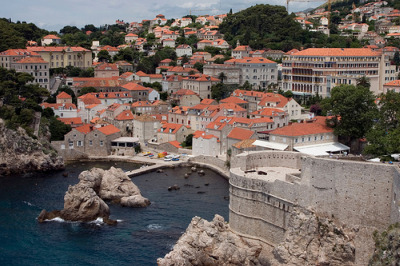
Getting from Italy to Croatia by Ferry

- Ferries from Venice to Croatia: >> to Mali Losinj, Piran, Pula, Rovinj, Porec, Rabac (Venezia Lines – these are passenger ferries only, no cars)
- Ferries from Ancona to Croatia: >> to Zadar, Split (Jadrolinija Ferries) >> to Split, Vis, Stari Grad/Hvar Island (Blue Line Ferries) >> to Split (SNAV Ferries)
- Ferries from Pescara to Croatia: >> to Split, Stari Grad/Hvar Island (SNAV Ferries or Jadrolinija Ferries)
- Ferries from Bari to Croatia: >> to Dubrovnik (Jadrolinija Ferries)
Look at a map of the departure and arrival ports listed above and you’ll understand why things like travel time and ticket prices will vary depending on where you’re leaving Italy, where you’re going in Croatia, and also when you’re making the trip. So you’ll need to look up all your options before deciding which one suits your travel budget and style best – but here are some reference points to get you started.
- A one-way ticket from Venice to Rovinj on Venezia Lines ranges from €48 in the low season to €53 in the high season (and that’s not including taxes, fees & surcharges).
- A deck-only one-way ticket from Ancona to Split or Bari to Dubrovnik on Jadrolinija Ferries ranges from €40 in the low season to €48 in the high season and €55 on a summer weekend. You can pay as much as €173 for a deluxe 2-berth cabin on that same trip on a summer weekend, and there are lots of options between those two extremes.
- A one-way ticket from Pescara to Hvar Island or Split on SNAV Ferries runs from €50-95 depending on the season and what promotions are going on.
- A one-way ticket from Ancona to Split or Hvar Island on Blue Line Ferries can be €40-48 for a deck ticket, all the way up to €116-136 for a “VIP Cabin” (with lots of options in between), and this doesn’t include any charge for a vehicle or the summer weekend rate increase.
- The trip from Venice-Rovinj takes about 2.5 hours if you get a direct boat.
- The trip from Ancona-Split takes about 9 hours.
- The trip from Bari-Dubrovnik takes about 8-9 hours.
- The trip from Pescara-Hvar Island takes about 4.25 hours.
For more information about all your options, your best bet is to check with the individual ferry companies. There are sites which claim to have the information for all the different companies, but in my searches I found some were outdated and others incomplete. If there’s one that’s always up-to-date and thorough, please let me know – but in the meantime (and even if there is) it’s probably best to check each ferry company’s website. Here are the sites for Jadrolinija Ferries , Blue Line Ferries , Venezia Lines , and SNAV Ferries . Be warned, not all of those sites are created equally when it comes to ease of use. Be patient… (Note that with the exception of the catamaran service from Venice to Croatia, the rest of the ferries you can take from Italy to Croatia are car ferries that also have passenger service. If you’re leaving from Venice, there’s no car ferry to Croatia.)
Flying from Italy to Croatia
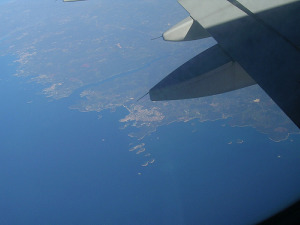
- easyJet – Milan to Dubrovnik, Milan to Split
- Germanwings – Milan to Zagreb, Bologna to Zagreb
- Ryanair – Pisa to Zadar
With a budget airline you can sometimes find one-way promotional fares for ridiculously low prices, even under €10. These fares are rarely as cheap as advertised, since the airlines then end up charging you for every little thing you thought was “free” on airlines, but it’s always worth looking – as long as you read the fine print. A quick scan of some of the round-trip tickets from Italy to Croatia at the time of this writing revealed a €11 fare to Zadar on Ryanair, a couple of €41 fares to Split and Dubrovnik on easyJet, and one that came in over €170 into Zagreb on Croatia Airlines. All of those options should be considered in the “extremely cheap” range, because you’ll also find fares in the €300-400 range as well for a flight from Milan to Dubrovnik or Rome to Split. As far as schedules go, remember that even though you’ll be seeing a flight that lasts less than two hours between Italy and Croatia, because it’s international travel (Croatia’s not yet part of the EU) you’ll need to factor in extra time spent at the airport and getting to and from the airport, as well. Be sure to weigh all that when you’re thinking about how much time a flight could potentially save over a ferry. Flights to Zagreb: Flights to Split: Flights to Dubrovnik: Flights to Zadar:
Getting from Italy to Croatia by Train

- Venice to Zagreb can take from 7.5-10 hours and can require 1-2 train changes along the way.
- Venice to Split can take from 15-20 hours and require as many as 3 train changes.
- Rome to Zagreb can take from 11.5-15.5 hours and require 1-2 train changes.
- Milan to Zagreb can take from 10-12 hours and require 1-2 train changes.
- A one-way ticket from Venice to Zagreb on the train can cost roughly $40-110 for a 2nd class ticket or $120-195 for a 1st class ticket (for direct trains that’s for either a couchette or a sleeper cabin, and including reservations where required).
Getting from Italy to Croatia by Bus
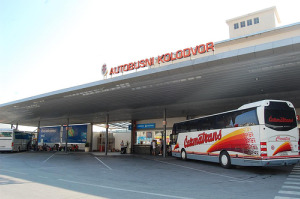
Driving from Italy to Croatia

And now that you’re in Croatia…
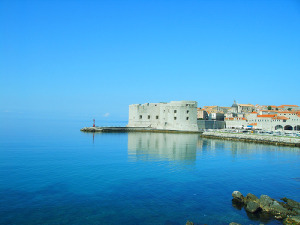
- BootsnAll has a Croatia travel guide you might find useful, called WhyGo Croatia.
- You’ll find all kinds of accommodation options in Croatia , including hotels in Croatia , hostels in Croatia , and resorts in Croatia (if you’ve got the budget for them!).
- There are plenty of things to do in Croatia , from sailing and diving to checking out the beautiful national parks .
photos, top to bottom, by: jimmyharris , lostajy , bortescristian , Goran Zec , kawanet , vacation2 , jonsson
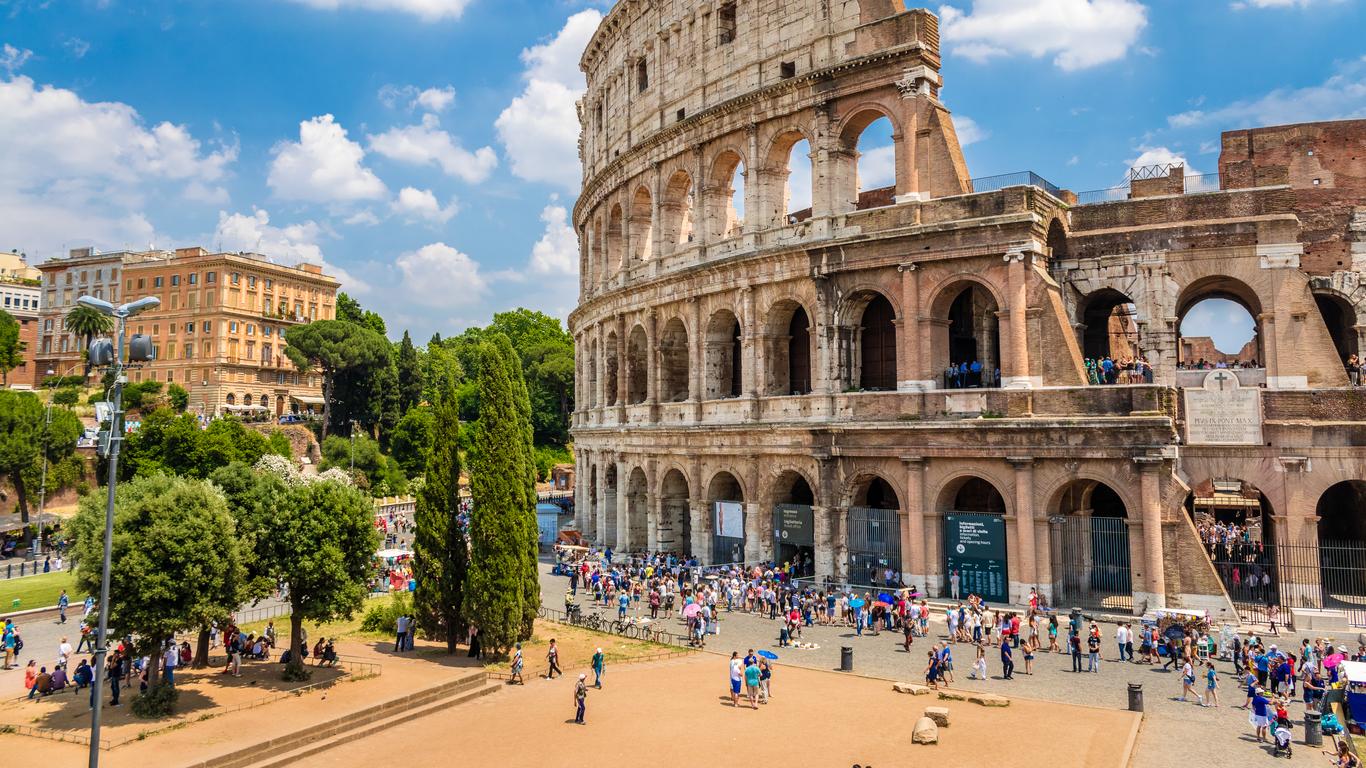
$34 Find Cheap Flights from Croatia to Italy
This is the cheapest one-way flight price found by a kayak user in the last 72 hours by searching for a flight from croatia to italy departing on 10/4. fares are subject to change and may not be available on all flights or dates of travel. click the price to replicate the search for this deal., search hundreds of travel sites at once for deals on flights to italy.
Save 22% or more Compare multiple travel sites with one search.
Track prices Not ready to book? Create a price alert for when prices drop.
Filter your deals Choose cabin class, free Wi-Fi and more.
Bundle and save Save money when you bundle your flight + hotel.
Good to know
Faqs for booking flights from croatia to italy, how does kayak find such low prices on flights from croatia to italy.
KAYAK is a travel search engine. That means we look across the web to find the best prices we can find for our users. With over 2 billion flight queries processed yearly, we are able to display a variety of prices and options on flights from Croatia to Italy.
How does KAYAK's flight Price Forecast tool help me choose the right time to buy my flight ticket from Croatia to Italy?
KAYAK’s flight Price Forecast tool uses historical data to determine whether the price for a flight to Italy from Croatia is likely to change within 7 days, so travelers know whether to wait or book now.
What is the Hacker Fare option on flights from Croatia to Italy?
Hacker Fares allow you to combine one-way tickets in order to save you money over a traditional round-trip ticket. You could then fly to Italy with an airline and back to Croatia with another airline.
What is KAYAK's "flexible dates" feature and why should I care when looking for a flight from Croatia to Italy?
Sometimes travel dates aren't set in stone. If your preferred travel dates have some wiggle room, flexible dates will show you all the options when flying to Italy from Croatia up to 3 days before/after your preferred dates. You can then pick the flights that suit you best.
Top 5 airlines serving from Croatia to Italy
Checking was efficient and quick. Adequate luggage space. Food for purchase only at high prices
Nothing. There was no flight. They cancelled the flight with no replacement about 9 hours before takeoff.
The flight was canceled at the last minute. Alternative flight was booked after 6 hours wait in Malaga airport.
Boarding with some sense and communication. It was a total free-for-all everyone coming all at once, no organisation of row numbers or priority.
Horrible, flight cancelled and had to come back the next day
Terrible. For clarity - this was the Level flight to Boston. Not Vueling. Would urge customers to avoid this airline. Gate agent was singularly unhelpful. He was argumentative, rude and went out of his way to ensure that every penny was collected for the baggage (which we realized given how early we were for flight we could have saved hundreds of dollars if we checked in on app). No onboard entertainment or WiFi. Half of the front section was empty because the seats did not work! Plane was falling apart.
No complimentary snacks, but I think that’s a standard in the USA. There were loud drunk Germans sitting in front of us.
Good standard flight the plan was clean could not complain the only thing is checking in the pushchair was very slow only 3 people at the counter.
The flight was delayed and nobody was able to inform me about the new scheduled time and gate
The flight attendants were friendly and professional. I asked to change my seat and the flight attendant was accommodating. We experienced a short delay due to the late arrival of the plane. However, the onboarding and disembarking process was efficient.
Boarding was annoying. Just at boarding they changed my bought and extra payed comfort seat for normal economy seat. And on my seat they placed someone else.
We had delayed flight (as usual for Dublin airport!!) for around an hour but the biggest surprise was the seats!! So tight with so tiny leg space. I could barely fit into it. Huge disappointment comparing with other airlines (even Ryanair). Complimentary water and crackers was nice touch but not be able to buy warm food like everywhere else is a joke. Also, on board prices are extortionate (even Ryanair is cheaper. Small can of coke is 4.5 euro!!)I remember times when it was actually lovely to fly with CA. I guess those times are long gone now.
Somewhere between ordering the ticket and the flight my checked bag was dropped and I had to pay more for a bag at the airport. I am very unhappy with your service.
It was great for a short flight - but due to turbulence no service, and there is no entertainment Appreciated leaving and arriving on time!
We payed for the seats and yet were bumped into others. One airbag under the seat was broken and hanging down, which made sitting down quite uncomfortable. Also tore up my stockings. Flight attendant didn't seem to care at all about that.
My comment before for Sarajevo-Zagreb fligh was actually abou flight from Zagreb to Amsterdam.
I was very dissapointed with a crew member who was acting very inpolite and talking down to one man who did not realize that he should not have brought his carry-on bag into the plane. She was making faces showing resent. It looked really bad.
The airline is ok there was a delay but I made home ok Serving water for local trip for international to Frankfurt it was cracker and water Since it was a short trip it was ok I would not recommend for long flight
Check in terminal not working and the bag fell back on me and tore the skin on my arm
Let us know the airport doesn’t open until 5 am.
Kayak sent several notifications that the flight was late. This contradicted the information on the airport boards. This was extremely confusing and we very nearly missed the flight purely because we double checked with the info desk when the flight stays said’closed’. Kayak notifications are therefore unreliable and pointlesa
Long delay resulted in my being unable to catch a train home and resulted in an additional £76 cost for an Uber
I was charged at the gate for bags I had already paid for. There was no other option. I am trying diligently thought easyJet website but making no progress HELP!
I was disappointed there was a 40 minute delay to flight
They cancelled my flight and we had to fend for ourselves to reschedule another flight. There was no staff to help all the canceled guest. Poor communication and staff. I attempted to reschedule via Kayak and I asked their staff that it looked as it was available. The guy behind the counter just told us to go online..
Nothing! The service was excellent for accessibly challenged passengers, Used lift and all support personnel very helpful. Will fly again.
Worst airline in the world, will never travel in it again.
Well Is extra charge for everything and other companies include that and the price.
easyJet need to ensure that whether pre-booking seats or not children aren’t split from their parents the crew spent the majority of boarding asking passengers to move to accommodate two families. Surely the system identifies minors on a booking !!!!! It was all very frustrating to watch and caused delays which I’m sure cost easyJet more in the long run rather that automatically allocating families with minors seats together automatically.
I am writing to share how your teams can better serve your youngest customers. On 9 January, 2024, I boarded and then de-boarded a flight with my 6 month old daughter. I have four children and travel extensively. Delays happen, but the stress my daughter had to ensure was avoidable with simple and straightforward actions. (1) communicate delays to customers -- Breastfeeding mothers are constantly timing feedings. If delays were communicated, I could have camly fed her instead of attentively waiting for priority boarding. There were no announcements and no updates to the monitor; (2) honor the priority boarding process -- While a staff member waved us in for priority boarding, half the plane boarded while the "priority check-in" representative was preoccupied; (3) anticipate challenges creating unnecessary stress to infants -- after completely ignoring the priority boarding procedure, and knowing that the plane had not even arrived, the team could have offered to board us last. My daughter could have been calm in the waiting area while breastfeeding. Instead my 6 month old was completely unnecessarily stressed in the middle of the jet bridge, packed in solid.
When having difficulty with the online check in process, I was forced to pay a huge fee for the check in desk to assist me with getting a boarding pass. Ridiculous!
Boarding was with buses, but they let people without priority boarding before people with priority boadring.
I forgot my headphones in the plane, how can I retrieve it?
Never have real problems...very ho prices for good the rest is all great
Would have been a very good flight, but busses did not meet the plane at the destination airport (NAP/Naples) for nearly one-half hour after landing. Clearly the airport concessionaire’s fault, not RyanAir’s.
Everything was OK but I got the feeling that the aisle seat in row 3 is smaller than the other 2 seats
The system of checkin by online only not good at all.. Because not everyone knows how to to do it and when the people go the airport without checking online it charge him, this really unfair 55 Euro this too much for nothing.. Thanks
The worst low cost airline in the world! It’s absolutely the poorest costumer service and my worst experience!
Terrible experince. The flight was delayed for 4 hours and we had to sit in the plane for 30 minutes without AC. At least they shouod have given us complimentary bottles of water but no one had to buy them.
The worst experience ever, really. First we had booked a flight at noon with about 6 months in advance. A month before the flight they cancelled it and rescheduled us on a flight a 21:00 hs which would ruin our day completely. Nevertheless, we had no option but to accept as any other option was economically unviable with so short notice. We arrived on time as requested to the airpor. Actually arrived 3 hours earlier. We waited there and it started to be delayed a few minutes, then an hour and a half and so son. Flight ended up boarding at 23:15. Once the doors were closed, the captain announced 1:30 more hours delay to start our trip. Also, as per “international rules” they said they couldn’t offer water or anything alike. After about 30 minutes, and against those rules, they started SELLING WATER BOTTLES FOR 3€ each. 500ml bottles. Flight departed at about 01:44 am and after a go around in Bergamo because he was at about 700 feet AGL and still not stable, the pilot performed a go around, landing at the same runway minutes later. Crew, both pilots and flight attendants, were professional and I told them I feel sorry for them having to deal with this everyday as it’s not their fault, but they’re the visible side of the airline to the passengers. Bags arrived promptly but we took our Uber at 03:55 am. Ryanair, never again! (It could be their slogan, but it’s probably too good for them).
I miss my flight due to boarding pass won’t load up
Flight schedule was modified and the final departure time delayed.
Big delay because of the weather but communication not so good. Boarding already late (due to tight schedule on Wizz side). When you get in you are hurried every second even if you still need a few seconds to arrange your bags. Food far away from how it looks in the catalogue and right on row 8 already out of chocolate although you are supposed to receive one for a menu. No replacement was offered.
The border control opens at 4:30 so there is no point in going in early as the wizz email suggests. Our flight utilized a plane with plastic seating which was really uncomfortable.
Check in took very long. All three priority agents left for lunch or something and the line did not move.
Il n’y a pas eu de vol du tout puisque celui à été déplacé à la veille sans aucune information. Aucun remboursement ni service client non plus. Scandale !
A GOOD IDEA IS TO SEND TO ME BOARDING PASS IN ADVANCE SO I DONT HAVE TO FIGHT FOR IT
Attesa lunga nella comunicazione del Gate e dopo l'apertura del Gate
Sempre in ritardo, bagni sporchi e sedili sporchi con le briciole
Wizzair is a mess, don’t trust them, all flights are delayed, nothing is secure with them, they are the poorest of all companies.
Book cheap flights from Croatia to Italy
Recent round-trip flight deals, search by stops, search by airline, search by price, recent one-way flight deals, last minute flights to italy, last minute flight, train and bus deals, everything you need to know for your flight to italy, complete your trip to italy with a hotel stay or car rental, find deals for your return flight.

- About Custom Planning
- Customization Possibilities
- How It Works
- Options & Pricing
COMFORT LEVEL
- Single Journey Standard
- Single Journey Luxe
JOURNEY TYPE

By Travel Style
By duration.
- 7 Days or Less
- 8 to 10 Days
- 11 to 14 Days
- 15 Days or More
By Destination
- Two Destinations
- Three Destinations
- Four Destinations or More
MORE PACKAGES
- See All Packages
- Deal Finder
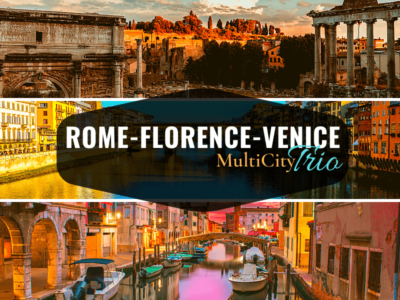
9 Nights/10 Days Escape to Rome, Florence, and Venice by Train
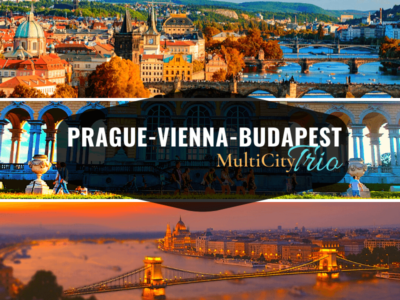
9 Nights/10 Days Escape to Prague, Vienna, and Budapest by Train
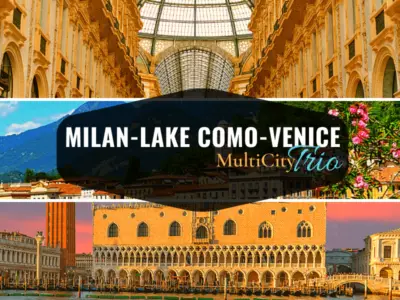
9 Nights/10 Days Escape to Milan, Lake Como, and Venice by Train
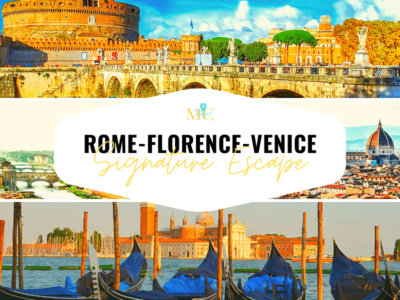
9 Nights/ 10 Days Signature Escape to Rome, Florence and Venice
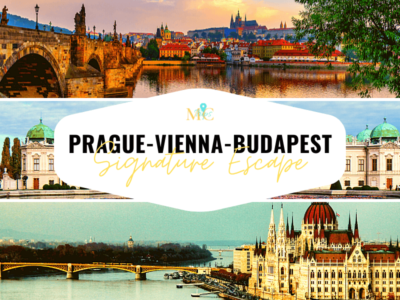
EXCLUSIVE TRAVEL CLUB
- About Insider Club Program
- Insider Exclusive Benefits
- Insider Cash Incentive Program
- Insider Membership Registration
INSIDER JOURNEYS
- Journeys Beyond Europe
- All-Inclusive Vacation Packages
- Weekend Getaways & Day Trips
- Other Special Occasions & More
MORE WAYS TO PLAN
- All Pre-Designed Packages
- Deal Finder (Insider Deals)
- Custom Trip Planning
INSIDER EXCLUSIVE DEALS

9 Nights/10 Days Journey Beyond Europe: Best of Thailand to Bangkok, Chiangmai, and Phuket

6 Nights/7 Days Journey Beyond Europe: Best of Morocco to Marrakech and Casablanca

5 Nights/6 Days Paris Exclusive Escape with Bateaux Parisiens Seine River Gourmet Dinner & Sightseeing Cruise

5 Nights/6 Days London Exclusive Escape with Day Trip to Windsor Castle, Stonehenge, and Oxford

5 Nights/6 Days Journey Beyond Europe: Canada Road Trip to Banff and Jasper National Parks

5 Nights/ 6 Days Rome Exclusive Escape with Day Trip to Tuscany Countryside Including 3-Course Lunch and Wine Tasting
Popular destinations, czech republic, switzerland.
- All Destinations

OUR DESTINATIONS
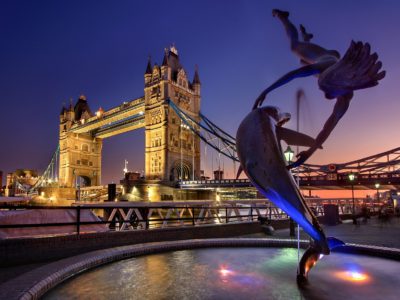
Luggage + Bags
- Suitcase Sets
- Kids' Luggage
- Duffel Bags
TRAVEL GEAR + ESSENTIALS
- Beauty & Cosmetic
- Packing Organizers
- Clothing, Shoes & Accessories
- Phone, Power Adapter & More
- Travel Guidebooks, E-Books
- Travel Gifts & More

OUR INSPIRATION
- All Inspiration & Blog
- Trip Inspiration
- Travel Stories
- Travel Accessories
- Travel Tips
- Food & Drink
Media & Publishing
Insider magazines.
- Newsletters
Our Community
- Travel Community
Travel Inspiration

The Best Italy and Croatia Itinerary Ideas for 7-14 Days Trips You’ll Love
Date: December 12, 2021 By MultiCityTrips Categories: 1 Week (6-9 Day Trips) 2 Week (10-14 Day Trips) Croatia Travel Italy Travel Itinerary Ideas Trip Inspiration No comments
Italy and Croatia are two of the best destinations in Europe and if you can’t decide which one to visit, there’s good news: you can easily visit both during the same trip! These three itineraries cover a similar route that are adapted and added on to for itineraries of different lengths so you’ll be able to find one that fits your travel plans.
Related Posts :
- 10 Days in Italy | 5 of The Best Itinerary Ideas for an Amazing 10 Days in Italy
- 10 of The Best Free Things to Do in Florence
- 10 of the Best Hidden Gems in Italy to Visit
7-Day or One-Week Italy and Croatia Itinerary
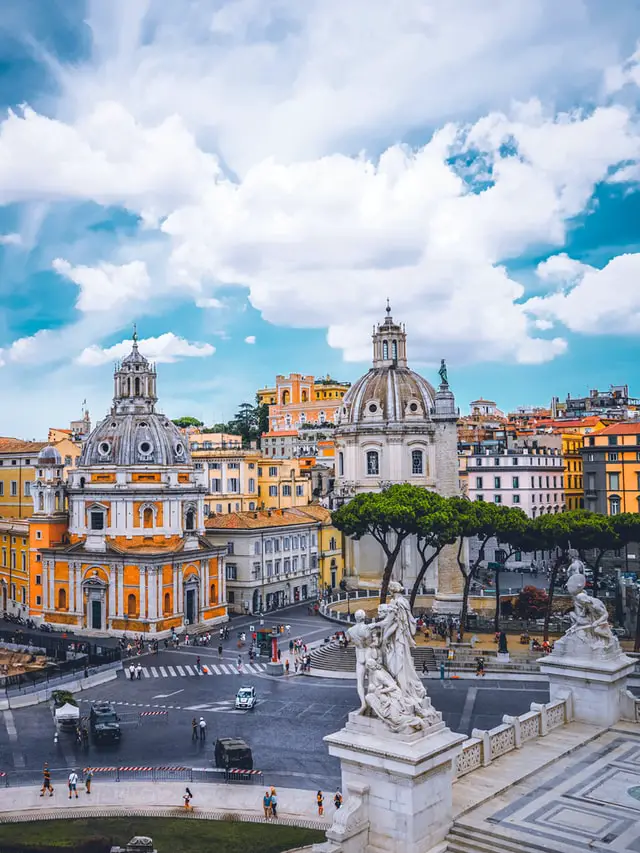
If you only have one week to explore Italy and Croatia, you’ll still be able to take a highlights tour of these incredible countries. Start your trip by flying into Rome . Italy’s capital city is rich with history and culture and you can spend at least two or three days here exploring some of the most famous ancient monuments in the world. Toss a coin over your left shoulder with your right hand into the waters of the Trevi Fountain – according to legend, doing this means you will soon make another trip to Italy.
From Rome, you’ll continue on to Venice where you’ll be able to see the famous canal city in person over the course of two days. Make sure you spend an afternoon taking one of the famous gondola rides through the city. Although this can be relatively expensive, it’s definitely worth it to participate in this iconic activity.
You’ll end your trip by heading to the Croatian city of Dubrovnik . This charming city is an extremely popular destination with a rich history. The Dubrovnik Walls are one of the most famous attractions in the city and you can walk along them and admire the view of the Old Town area and climb Minceta Tower. They’re famous in pop culture for their appearance on HBO’s smash hit Game of Thrones and you may be able to find a guided tour that is based on the show when you are there. In addition to exploring these picturesque walls, you can eat local food and shop for Croatian goods to take home as a souvenir.
Travel Guide & Resources for This 7-day or One-Week Italy and Croatia Itinerary:
Enjoy this 7-day or one-week Italy and Croatia Itinerary itinerary? Here you can find the best flights , train tickets , or rent a car for your trip to Italy and Croatia. Also, here you can browse our list of the best hotels in any destinations mentioned in this Italy and Croatia itinerary to stay in.
Need more ideas to add to your one-week or 7-day Italy and Croatia Itinerary? Find top attractions & things to do in Italy and Croatia in addition to what is already mentioned here.
10-Day Italy and Croatia Itinerary
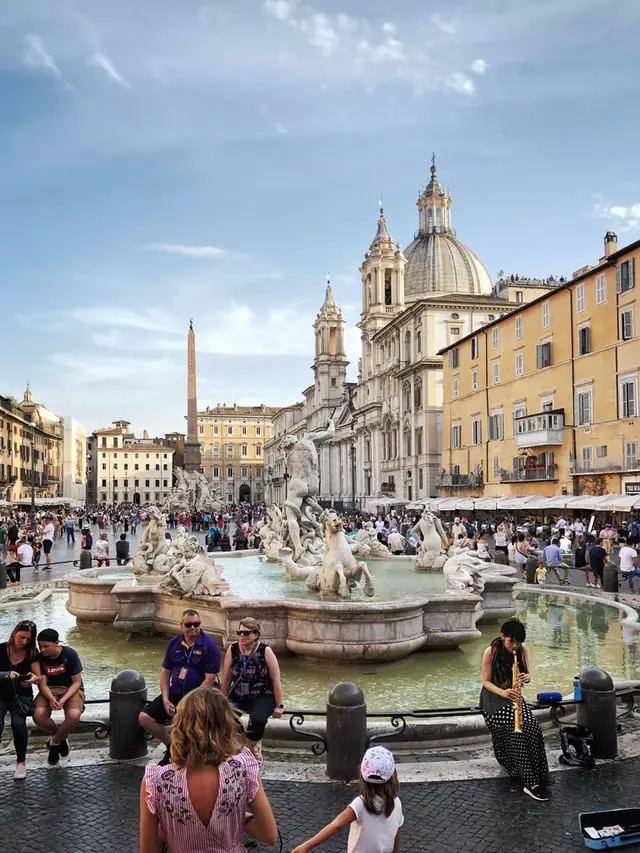
If you have ten full days to explore Italy and Croatia, you have several more opportunities to see incredible sights and experience vibrant culture. As with the previous itinerary, you will start this ten day vacation by flying into Rome and spending three days exploring the sights. If you love museums you can head to the Vatican Museums which are widely considered to be some of the best museums in Europe, if not the entire world. The museum has nearly 70,000 remarkable historic and artistic items in it’s total collection, 20,000 of which are on display. One of the most famous is Michelangelo’s The Creation of Adam , the famous painted ceiling of the Sistine Chapel. While near the Vatican, spend some time exploring St Peter’s Basilica, another structure that Michaelangelo helped create.
From Rome, head north to Venice . In addition to a gondola ride, you can spend your time in the famous canal city walking across the nearly 400 bridges that cross the waterways. If you happen to be visiting during late February or early March, you might have a chance to experience the vibrant Venice Carnival which is famous for its elaborate masks. Pick one up from one of the local artisans when you visit.
After exploring Venice you’ll head into Croatia and towards the capital city of Zagreb . You can fly there or you can opt to drive although that trip can take around five hours. This fantastic destination blends the historic with the modern and the result is a charming city where you can learn about Croatia’s history and culture. Gradec is a quaint neighborhood where you can shop and grab a bite to eat. Dolac Market is a daily farmer’s market where you can also pick up some fresh food that makes for a quick and healthy breakfast.
During your stay in Zagreb, you can book an excursion to the incredible Plitvices Lake National Park . This UNESCO World Heritage Site is Croatia’s largest and oldest national park and is a stunning natural landmark that is just under two hours away from Zagreb. There are several different companies that offer day trips that provide transportation and in some cases, meals are provided as well. These tours are a great way to explore the natural beauty of Croatia without having to rent a car.
After three days exploring Zagreb and taking a day trip to Plitvices Lake National Park, you’ll continue on to your final stop on this itinerary: Dubrovnik . In addition to the Dubrovnik Walls, you can explore the Stradun which is a pedestrian area lined with stores and cafes. After your time in Dubrovnik, you can easily continue on to other destinations or head home by flying out of the Dubrovnik Airport.
Travel Guide & Resources for This 10-Day Italy and Croatia Itinerary Itinerary:
Enjoy this 10-day or one-week Italy and Croatia Itinerary itinerary? Here you can find the best flights , train tickets , or rent a car for your trip to Italy and Croatia. Also, here you can browse our list of the best hotels in any destinations mentioned in this Italy and Croatia itinerary to stay in.
Need more ideas to add to your one-week or 10-day Italy and Croatia Itinerary? Find top attractions & things to do in Italy and Croatia in addition to what is already mentioned here.
14-Day or 2-Week Italy and Croatia Itinerary
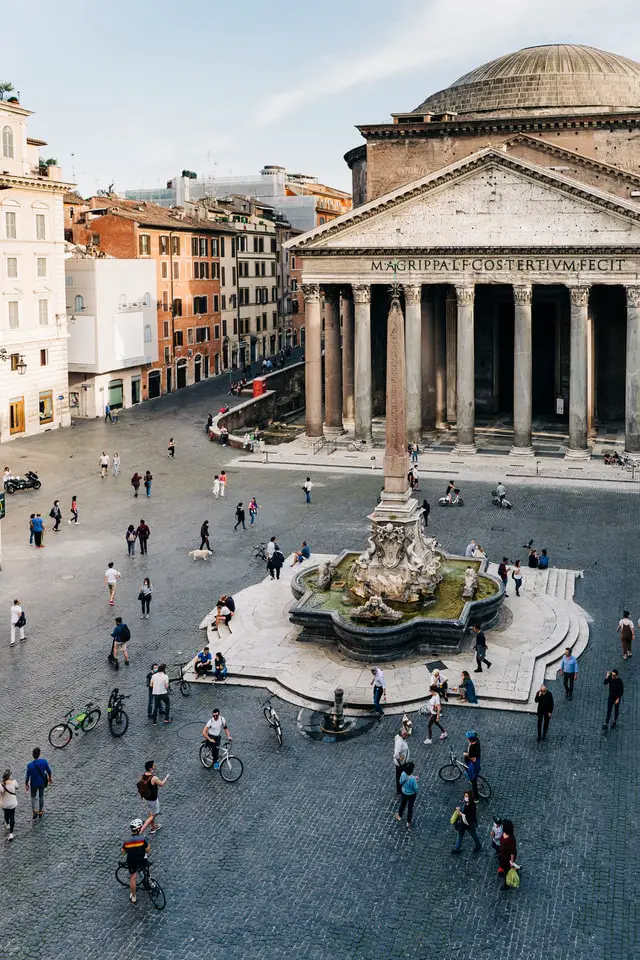
If you have a full two weeks to explore Italy and Croatia, you’ll have plenty of opportunities to explore some of the best sights in the country. As with the other itineraries, you’ll start by flying into Rome . In addition to being home to a major airport and being easy to get to, Rome is a great place to start your Italian adventure as there are several iconic monuments within city limits and plenty of opportunities that are designed for tourists such as guided experiences in languages other than Italian.
Following your time in Rome, head north to Florence . The city has long had a reputation for encouraging art and many famous creators were either born in Florence or established a residence there in later years. For example, if you head to Piazza della Signoria, you can see the iconic Statue of David. This marble sculpture was created between 1501 and 1504 by the famous artist Michalangelo. Visit the Cattedrale di Santa Maria del Fiore to see one of the most famous cathedrals in the world.
After exploring Florence, you can continue up north to Venice before heading into Croatia. You can spend just a day and a half exploring the city by land and by gondola before continuing on. Make sure you stop by the famous St. Marks Square where you can explore cafes and shops while enjoying stunning views of the blue waters framed by the terracotta colors of the structures.
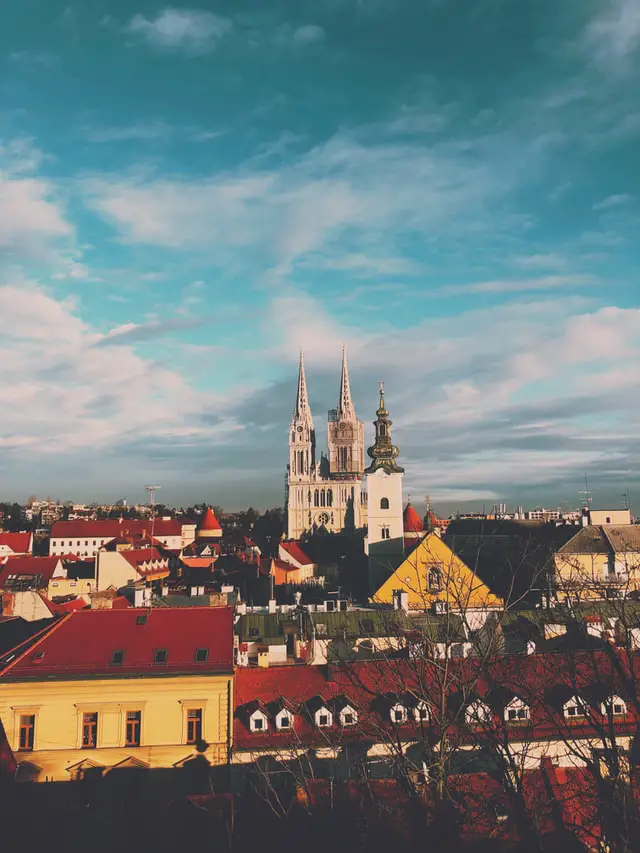
After your time in Venice, you’ll fly into Zagreb , Croatia’s capital city. In addition to fresh food and charming medieval alleyways and neighborhoods, you’ll be able to spend your time here visiting historic sites such as Karlovac – a 16th century town that was built as an outpost to defend against the Ottoman army. It is a fascinating example of military planning and is also a beautiful spot. For a more unconventional route, head to the Museum of Broken Relationships. This museum contains items from heartbroken people around the world along with a brief explanation as to what these seemingly random items are. It might not sound like a good time but the galleries are poignant and remarkably human.
Next, you’ll start heading south – specifically towards Plitvice Lakes National Park . You’ll rent a car for this part of your trip and you’ll be able to experience some stunning scenery and unique aspects of Croatian culture you’d miss if you were flying over it. If you’re heading to the park without a tour guide you’ll have the complete freedom to hike and explore the area at your own pace. You can even opt to stay overnight at a nearby hotel like the beautiful Plitvice Hotel. You can rest and explore the park for a few hours the next morning before continuing on.
After exploring Plitvices Lake National Park , you’ll continue on to Split , Croatia’s second-largest city. Split is a cultural hub in the region and is also home to several historic landmarks such as the Diocletian’s Palace, which was erected for the Roman Emperor Diocletian in the 4th century AD. Today you can tour the palace and even see it from Split’s Old Town neighborhood.
Finally, continue on to Dubrovnik . You can spend your days here exploring the remnants of imposing historic sites and immersing yourself in Croatian culture before heading home.
Travel Guide & Resources for This 14-day or Two-Week Italy and Croatia Itinerary:
Enjoy this 14-day or two-week Italy and Croatia Itinerary itinerary? Here you can find the best flights , train tickets , or rent a car for your trip to Italy and Croatia. Also, here you can browse our list of the best hotels in any destinations mentioned in this Italy and Croatia itinerary to stay in.
Need more ideas to add to your 14-day or two-week Italy and Croatia Itinerary? Find top attractions & things to do in Italy and Croatia in addition to what is already mentioned here.
Video Guide: Italy & Croatia Itinerary Ideas for 7, 10, & 14 Days
Related Posts
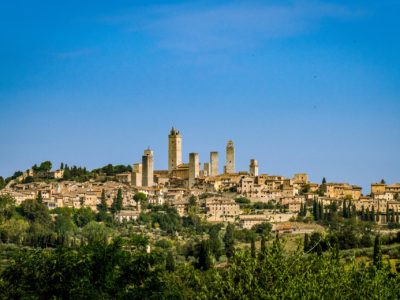
Travel resources for planning a multi-city trip to Italy and Croatia
To make planning a trip to Italy and Croatia easier, we included some of our recommended travel resources below. You can search and find the best flights, transportation options, hotels to stay in, tours/activities, and things you can do in each destination during your trip to Italy and Croatia.
Agoda : Search thousands of destinations around the world & quickly compare prices to find amazing deals on the best flights.
CheapOAir : You can find airline tickets, hotel rooms, rental cars, and vacation packages all on one site!
Kiwi.com : What we like about Kiwi is the fact that they are able to create combinations of flight, train, and bus tickets and offer them in a single itinerary. Also, Kiwi has what they called “ Nomad ” which helps you find the best way of visiting multiple destinations, saving you time and money.
JetRadar : You can search and compare airfares from 726 airlines and dozens of travel agencies and systems.
Agoda : Agoda is one of the world’s largest online travel accommodation platforms with a network of over 2,000,000 vacation rentals and hotels worldwide.
Hotellook : They have more than 250,000 hotels in 205 countries, working with data from more than 10 online booking systems, such as Booking.com, Agoda.com, Hotels.com, Expedia, and others.
Transportations:
Airport Transfers : KiwiTaxi , Viator
Train : EuRail , Trainline or RailEurope
Bus : Flixbus : Very affordable (as low as $6) and convenient way to transfer between cities in Europe.
Car Rentals : AutoEurope , EconomyBookings , or GetTransfer (transfers & car rentals with a personal driver)
Bike Rental : BikesBooking (Bikes & scooter rentals)
Transportation Comparison : Omio (search, compare, and book tickets for buses, trains, and flights all in one site)
Tours & Activities :
TakeWalks (WalkofItaly): This is our favorite site for walking tours & day trips.
Tiqets : Great site for entrance tickets. It offers directly bookable, instantly available, and completely mobile tickets for museums, shows, and attractions all over the world.
Musement : They have good activities and tours in Italy and Spain, also many great day trips you can choose from.
GetYourGuide : A large number of tours, excursions, and other travel activities
Viator : The largest one. It has everything from tours, attractions, shore excursions, and private guides in over 2,700 destinations worldwide. It also has many transportations and transfers options and some unique experiences we didn’t find anywhere else.
Need help planning a trip to Italy and Croatia ?
Want to plan a trip to Italy and Croatia but don’t know where to begin? If you find this type of trip planning to be too complicated to plan on your own, we’re here to help!
At MultiCityTrips , multi-destination travel and complicated itineraries such as a multi-city trip to Italy and Croatia are our specialties. Contact us today to learn more about how one of our experienced travel experts/destination specialists can personalize your multi-city vacations at the best price.
Don’t want to start from scratch and need some trip inspiration? Check out our marketplace for customizable pre-designed packages available right now for many amazing destinations.
To learn more about how our process of trip planning works in detail, please see our “ How It Works ” page or check out our video on “How to Plan a Multi-City Trip to Europe in 5 Easy Steps” here.
Have questions for us? Schedule a FREE Call with us here or contact one of the travel experts/destination specialists at [email protected] , call/text us at (888)223-2316 today.
Forgot your password?

- Living In Croatia
- Croatian Recipes
- Balkan Recipes

Home > 4 Ways To Get From Italy To Croatia With Italy To Croatia Ferry Info
4 Ways To Get From Italy To Croatia With Italy To Croatia Ferry Info

Written by our local expert SJ
Sarah-Jane has lived in Croatia for 10+ years. SJ, as she is known, has been traveling the Balkans & beyond since 2000. She now shares her passion for traveling with her husband & kids.
This detailed transportation guide tells you how to get from Italy to Croatia and from Croatia to Italy. It includes all the ferries from Italy to Croatia.

If you’re keen to get from Italy to Croatia, there are several options in front of you. That means you can enjoy Italy’s delicious food, culture, and beauty and then hop over to Croatia and check out the history, local delicacies, and amazing beaches.
Skip Ahead To My Advice Here!
Croatia To Italy Distance

Well, depending on your mode of transport, that is a hard question to answer. By road, from Zagreb to Rome is 885 km (550 miles), which takes around 9 hours to drive. The flying distance from Rome to Zagreb is 321 miles (517 km).
So now, you want to know “ how can I get from Italy to Croatia ,” right? Let us show you how.
Flights From Italy To Croatia
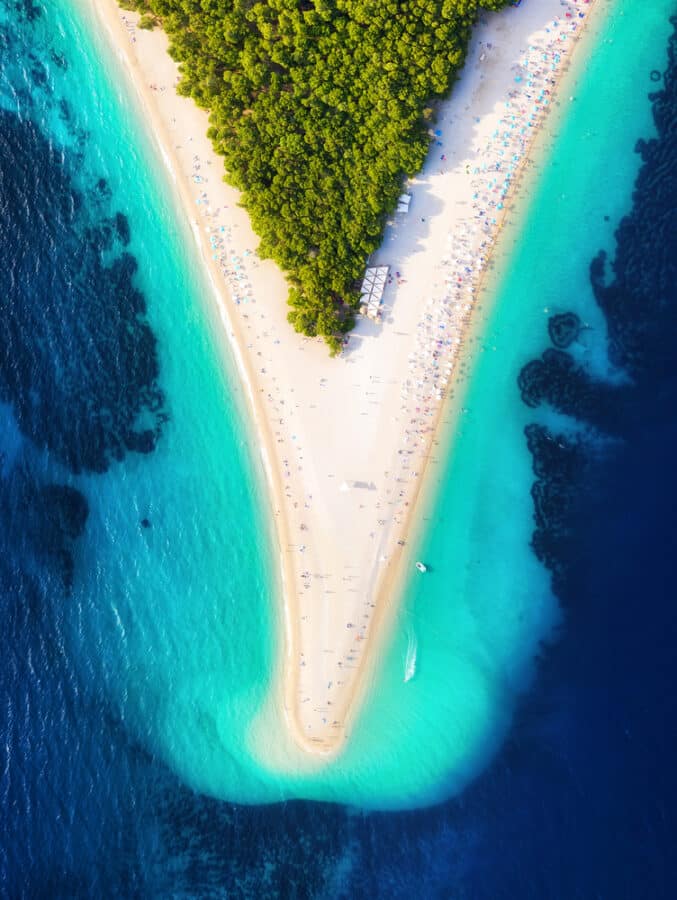
Of course, the easiest way is to fly, and that’s especially easy during the summer months. Many airlines service several Italian cities and connect to different parts of Croatia, many of which are low-cost airlines, too – bonus!
Some airlines also provide services during the winter months, although these are less frequent.
Croatia Airlines
- Milan Malpensa to Zagreb and Split
- Bologna to Zagreb
- Rome to Split and Dubrovnik (this service is year around)
- Venice to Dubrovnik
- Milan Malpensa to Zadar and Split
- Naples to Split and Dubrovnik
- Rome Ciampino to Zagreb (this service is year-round)
- Rome Ciampino to Zadar and Split
- Milan Bergamo to Zagreb (this service is year-round)
- Rijeka to Zadar
- Milan Malpensa to Zadar
- Bologna to Zadar
- Naples to Zadar
- Turn to Zadar
- Bari to Zadar
- Rome Fiumicino to Split and Dubrovnik
Take a private transfer from the airport to your destination.
Brands we use and trust, driving from italy to croatia.

If you want to drive from Italy and Croatia , it will undoubtedly be a very scenic affair! You can take your own car or hire one, with Avis, Europcar, Maggiore, and Sixt allowing rental vehicles to be taken from Italy to Croatia. Some will let you do a one-way rental, but do check and know that it will be a LOT MORE expensive.
The easiest route is from Trieste in Italy to Koper in Slovenia, and then driving into Istria , Croatia, from there.
As you are crossing borders, you’ll need to have all documentation ready to show at the border crossing, and now that Croatia is a part of the Schengen Zone, the long waits to cross the borders during summer are now avoided.
Get a quote on a car rental here.
Ferry from italy to croatia – italy to croatia ferry, can you take a boat from italy to croatia.
Yes, and there are several options you can take to get to Croatia from Italy by ferry. They vary in time, according to the operator and the route you choose. Most ferry routes only operate in the summer months, but some are year-round. If you’re opting to travel by ferry during the winter months, be prepared for delays and cancellations at the last moment due to bad weather.
Ferry To Croatia Options
From venice to croatia.
- Venice to Piran
- Venice to Umag
- Venice to Poreč
- Venice to Rovinj
- Venice to Pula
- Venice to Mali Lošinj
- Venice to Novalja ( Island of Pag)
- Venice to Rab
- Venice to Zadar
From Trieste To Croatia
- Trieste to Pula
- Trieste to Rovinj
- Trieste to Rijeka
From Ancona To Croatia
- Ancona to Zadar
- Ancona to Split
- Ancona to Hvar (Stari Grad)
- Ancona to Dubrovnik
Other Ferries From Italy To Croatia
- Cesenatico to Mali Lošinj
- Pesaro to Mali Lošinj
- Civitanova Marche to Split
Jadrolinija launched a new ferry line connecting Italy and Croatia in 2023. They started in May, connecting Split, Croatia, and Bari, Italy, once a week until October.
Busiest Ferry Routes From Italy To Croatia
- Italy to Dubrovnik
- Italy to Zadar
Common Departure & Arrival Cities
- Venice to Pula , Rovinj, Umag & Porec
- Ancona to Zadar & Split
- Bari to Croatia ferry arrives in Dubrovnik & Split (new as of May 2023)
- Trieste to Rovinj, Mali Losinj, Porec
- Cesenatico to Mali Losinj, Rovink
- Pesaro to Mali Losinj
On the flip side, the same return ferries from Croatia to Italy operate.
Despite some sites claiming there to be a ferry Hvar to Italy – sadly, there is not one. But you can reach the island of Hvar easily once you arrive in Split.
To give you an idea of the times, the ferry from Venice to Porec takes 2 hours 45 minutes, with four crossings per week. Trieste to Rovinj with Liberty Lines takes 2 hours 30 minutes, and there are two crossings per week.
But if you choose to sail from Ancona to Zadar with Jadrolinja, there are two sailings per week, which will take you 8 hours. Similarly, Bari to Dubrovnik is another long one, at 10 hours and three crossings per week.
Book your ferries from Italy to Croatia here.
Move this adventure to your inbox & get an instant freebie.

No spam. Unsubscribe at any time.
Croatia From Italy By Train
Traveling between Italy and Croatia by train is the less popular option, but it can be done if you’re not short on time. The train isn’t direct as you’ll need to connect in Ljubljana , Slovenia.
The Trieste to Zagreb via Ljubljana service departs twice daily and takes about 8 hours, costing around 20 euros for a one-way ticket.
In our opinion, the best way to travel from Croatia to Italy is to take a ferry from Italy to Croatia. Either that or fly into Italy and get a private transfer from Venice to Pula or Zadar.
- How To Take The Ferry From Italy To Greece
- All The Ways To Get From Italy To Greece
- Taking The Ancona To Split Ferry
- How To Get From Venice To Zagreb
- How To Get From Turkey To Croatia
- How To Travel Between Greece & Croatia
Leave a Reply Cancel reply
Your email address will not be published. Required fields are marked *
Save my name, email, and website in this browser for the next time I comment.
This site uses Akismet to reduce spam. Learn how your comment data is processed .
Subscribe To Unlock Your FREE Customizable Travel Packing List & All Our Best Tips!
Unlock Your FREE Customizable Travel Packing List!
Subscribe Now For Instant Access To Stress-Free Packing
- Ekorna EXPERIENCE
Ekorna > Blog > From Italy to Croatia – by land, sea & air
From Italy to Croatia – by land, sea & air
Are you visiting Europe and wonder how to get from Italy to Croatia . Even though these two countries don’t share a border, there are still no less than 3 options to get from one place to another: by land via Slovenia; on a plane from various airports; or by a ferry from either Venice, Bari or Ancona. To make your choice easier, we have prepared a short summery of the options you have, hopefully you will find some useful information.
Before you get started, we just want to introduce ourselves. Ekorna Travel Agency is a local agency, specialised in tailor-made trips all over the Balkans and the neighbouring countries. Needless to say, that as professionals working in this field, we can get you from Italy to Croatia or any other place in the area in no time.
for a tailor-made tour of Croatia

➨ From Italy to Croatia by land
If you are located in northern Italy , getting to Croatia by land is probably your best option. Departing from Venice to the north of Croatia (for example to catch a cruise from Opatija ), doing it by land, passing through Slovenia , it will take less time, than doing it by ferry and most probably even by plane.
Technically – there are no borders between Italy and Slovenia , since the two countries are both part of the Schengen area . This is a group of 26 EU member states which decided to officially abolish all all types of control at their mutual borders. Croatia as of today, still isn’t a member of this group, but is scheduled to join in the near future. Even though you will still have to show the passport or ID card at the the border, you will don’t need any additional visa, as Croatia is already member of the European Union. This might sound confusing to non-Europeans, but it really isn’t. 😉
If you are renting a car in Italy, it will cost a fortune to drop it off in another country. In many ways it would be way cheaper to get a private transfer from Venice or Trieste to one of the Croatian towns. We can help you organise transfers from several Italian cities Milan, Venice, Bologna, Trieste and others.
There are also buses and trains running from all major towns, but most of them are indirect , meaning you will have to make a stopover in Slovenia . But that’s ok! Why not add another country to your travel list, right? Most transportation lines run through the capital of Ljubljana where you can easily kill a few hours before continuing to Zagreb or Rijeka.
➨ From Italy to Croatia by ferry
One of the ferry lines most used by tourists is the one linking Venice to Pula , a historic town located on the very tip of the peninsula of Istria . Another istrian town that has a ferry line connection with Venice is Rovinj, a picturesque fishing village also famous for great gastronomy experiences. In both cases it takes about three and a half hours to get from one country to another, making it the fastest way to get from Italy to Croatia on water.
Others popular ferry lines are those that connect Ancona with Split or Bari with Dubrovnik , if you are travelling in the south of Italy. These ferry lines are longer and usually take a whole night to cross the Adriatic Sea. We recommend booking a comfortable cabin in advance.
No matter where you entry point is, our custom-made itineraries of Croatia can be completely modified according to your wishes and travelling options. We can organise a driver guide who will pick you up right after your ferry lends and takes you to the hotel and later a guided tour of the town.
You should know that most ferries have bars , where you can buy a soft drink or something to snack on. That will definitely make your trip from Italy to Croatia by ferry a whole lot easier. Even more so, if you are travelling with children , as most ferries also has a zone, where they will put cartoons on common televisions. There are even ferries, which have areas for children as a toy library, usually in those that have a longer journey.
Nowadays, most ferries offer wifi to passengers, although there is probably not a very good connection, due to the high demand that usually exists. Normally it is very slow and the connection is lost, so do not trust too much in this service.
Ferry prices vary depending on the time of year, we can find rates from 45 to 70 euros one way and per person, depending on the chosen itinerary.

➨ Flights between Italy and Croatia
This is very simple, there are many different connections from Italy to Croatia by a plane. Flights are short and popular, so it’s easy to find them. The vast majority are connected to one of Croatia’s two main airports – Zagreb Airport, the capital of Croatia, and Dubrovnik Airport on the opposite side of the country.
You will have no problem finding flights by either low cost carries or national airlines of Alitalia and Croatia Airlines . Milan, Rome or Venice all have great connections with either Split , Dubrovnik and/or Zagreb .
If you need more help to get from Italy to Croatia, get in touch with us. We are a local travel agency specialised in custom-made trips all over the Balkans , including Croatia. Besides getting you here from basically any place in the world, we can also organise an unforgettable travel experience .
In addition to private and deeply personalised tours, we also organise escorted tours and popular small ship cruises.
for a tailor-made tour to the Balkans
Interesting itineraries

Pearls of Croatia
Travel 8 days

Croatian islands: Dubrovnik - Opatija
from 2.249,00 €!

Pearls of Slovenia and Croatia
Our destinations.
➨ Travel to Slovenia ➨ Travel to Croatia ➨ Travel to Montenegro ➨ Travel to Bosnia ➨ Travel to Serbia ➨ Travel to N. Macedonia ➨ Travel to Albania ➨ Travel to Romania ➨ Travel to Bulgaria
Types of trips
➨ Tailor-made trips ➨ Cultural tours ➨ City Breaks ➨ Escorted Tours ➨ Hiking & Cycling Trips ➨ Fly & Drive Trips ➨ Unique Experiences ➨ Small Ship Cruises
[email protected] 00386 40 935 093 Litijska 43, Ljubljana, Slovenia
Terms and conditions
Travelling from Italy to Croatia by Car: Routes, Ferries, and Visa Information
Choosing where to cross between bosnia and herzegovina and croatia, road conditions:, essential regulations for road users:, travelling to croatia from italy as an eu citizen, travelling to croatia from italy as a non-eu citizen, travelling from italy to croatia as a schengen visa holder, road routes from italy to croatia, route via trieste, route via trieste to istrian peninsula, route via udine, tourist attractions in western and southern croatia, route via palmanova, tourist attractions near zagreb and in eastern croatia:, journey time and season of operation, a journey worth taking.
Croatia -- scenic beauty, historic cities, sparkling coastline -- has all the ingredients for an amazing southeastern Europe vacation. A visit from Italy to Croatia is easily achieved. There is no direct Italy-Croatia border crossing. However, there are options by land, sea, and air to make the short journey. The best option is overland, travelling through landscapes rich in history and culture. Here, we offer advice regarding planning and implementing a trip from Italy to Croatia. We'll look at information about the roads used during the trip and immigration requirements. And, we share the major routes from northern Italy to Croatia -- both western and eastern. We've also included some of the popular attractions in each region. Lastly, we inform you of other ways to travel between the two countries. You'll find additional useful information about Vignettes for toll roads, on our website.
Tolls and Road Conditions
Before hitting the road, it's crucial to be aware of tolls and road conditions in Croatia.
Many of the motorways require the payment of tolls. Carry either local currency or a credit card. Fees can be paid at toll booths or online.
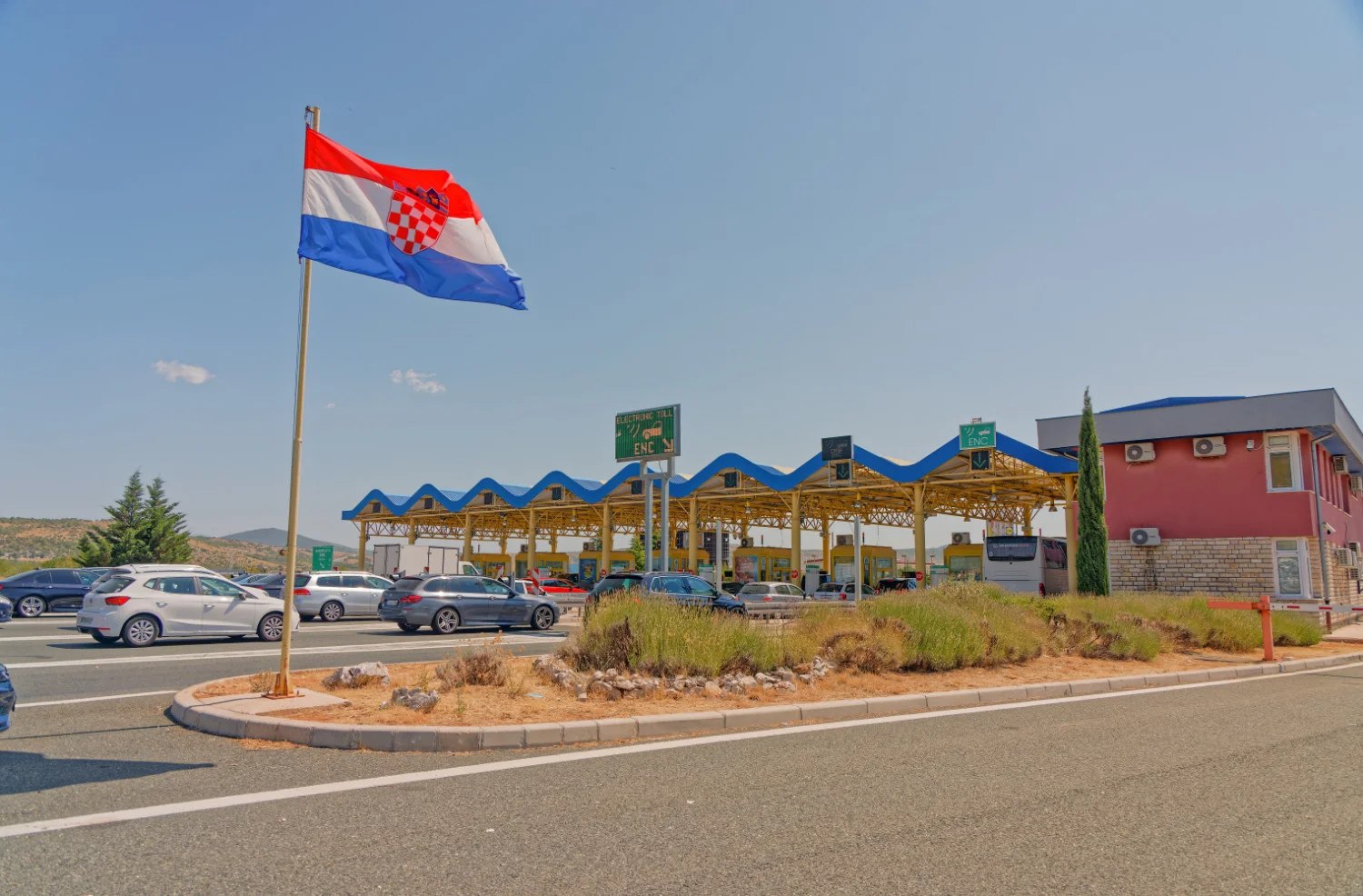
The roads in Croatia, Slovenia, and Italy are generally excellent. However, there may be detours, so it is best to check road information portals online before travelling.
Here are some essential road traffic regulations in Croatia. Be sure to familiarise yourself with regulations in Slovenia and Italy too. Also, take a look at our article about speed limits in Croatia:
- Drive on the right-hand side of the road.
- Seatbelt use is compulsory.
- Carry a valid driving licence, registration documents, and insurance papers.
- The speed limit is 50 km/h in urban areas, 90 km/h on open roads, and 130 km/h on highways.
- Headlights must be switched on at all times.
- Do not use your mobile phone, unless equipped with a hands-free kit.
- Blood alcohol concentration limit is 0.05%. Do not drive under the influence of alcohol or drugs.
If you are a citizen of a European Union member country, you have the privilege of visa-free travel. Have your valid identification documents (passport or national identity card) available for border checks. If you're on the way to Serbia [INSERT LINK URL WHEN AVAILABLE], our article will tell you all you need to know about border crossings.
As a non-EU citizen wishing to enter Croatia or neighbouring countries Slovenia and Italy, check the visa requirements specific to your nationality. Visit the website of the Croatian Embassy or Consulate for detailed information while still in your home country.
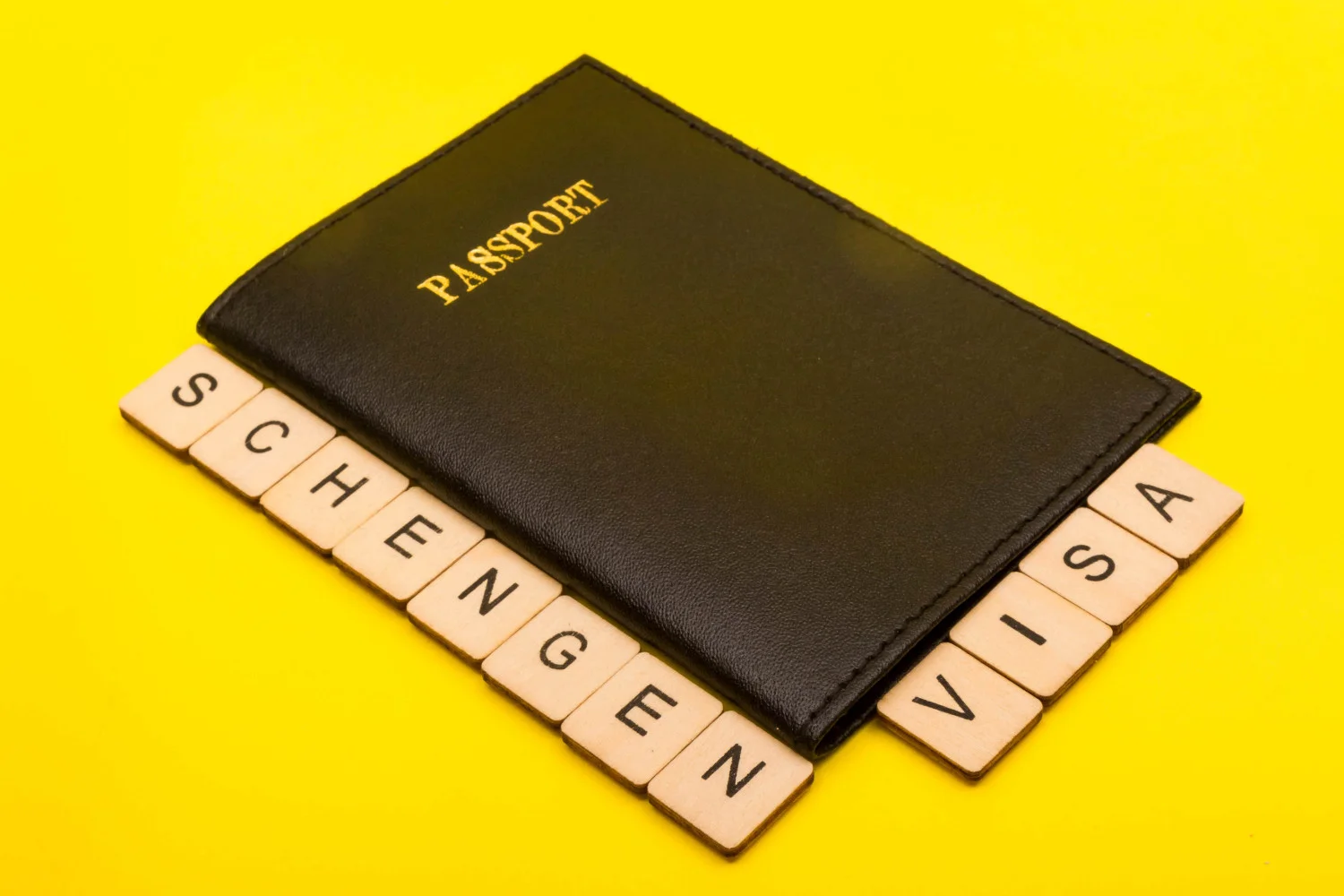
If you are in possession of a Schengen visa, you may enter the Republic of Croatia without a separate Croatian tourist visa. Ensure your visa is valid for your entire stay in Croatia. The specific rules and regulations applicable to Schengen visas will apply.
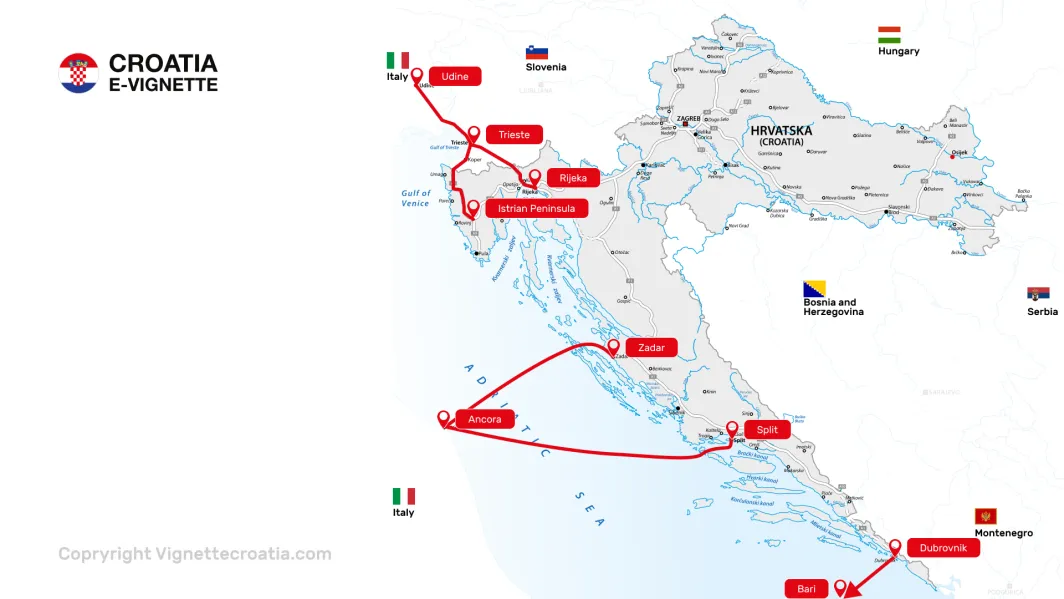
As this article is primarily for car users travelling from Italy, here are the popular roads. All routes start in northeastern Italy.
Recommended Routes for Travelling to Rijeka, Western, and Southern Croatia
- From Trieste, take the E61 through Slovenia.
- Cross the border at the town of Pasjak and continue on the A7 to arrive in the city of Rijeka.
- Approximately 3 hours, covering around 240 kilometres.
Alternatively, if you are heading to a destination on the Istrian Peninsula, avoid a long detour via Rijeka by:
- Following the E751 via Koper, Slovenia, to the Croatian border
- Continue on the E751 to your destination in this region:
- Arrive after 45 minutes, covering about 40 kilometres.
- Use the A23/E55 highway from the city of Udine, Italy.
- Enter Croatia at the town of Rupa and connect to the A7 towards Rijeka.
- About 3 hours, covering 250 kilometres.
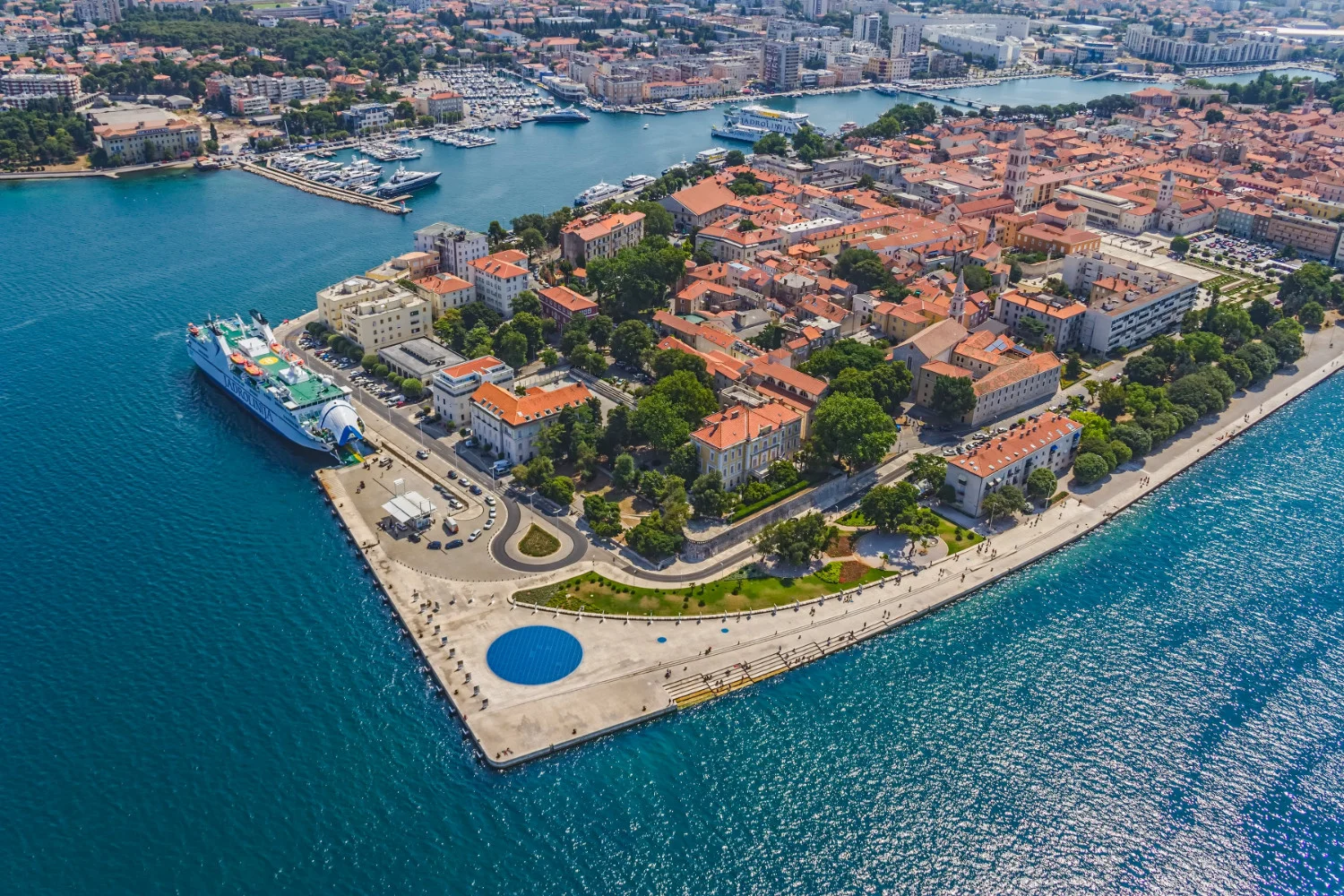
- Plitvice Lakes National Park
Recommended Routes for Travelling from Italy to Croatia's capital, Zagreb and Eastern Croatia
If heading to Zagreb or planning to explore the eastern regions, consider the following routes:
- Drive on the E70 from Palmanova to Villese
- Join the E61/A34 to the Slovenian border and continue to Ljubljana
- Rejoin the E70/A2 and over the Croatia to Italy border crossing towards Zagreb.
- Approximately 3 hours, and 268 kilometres covered.
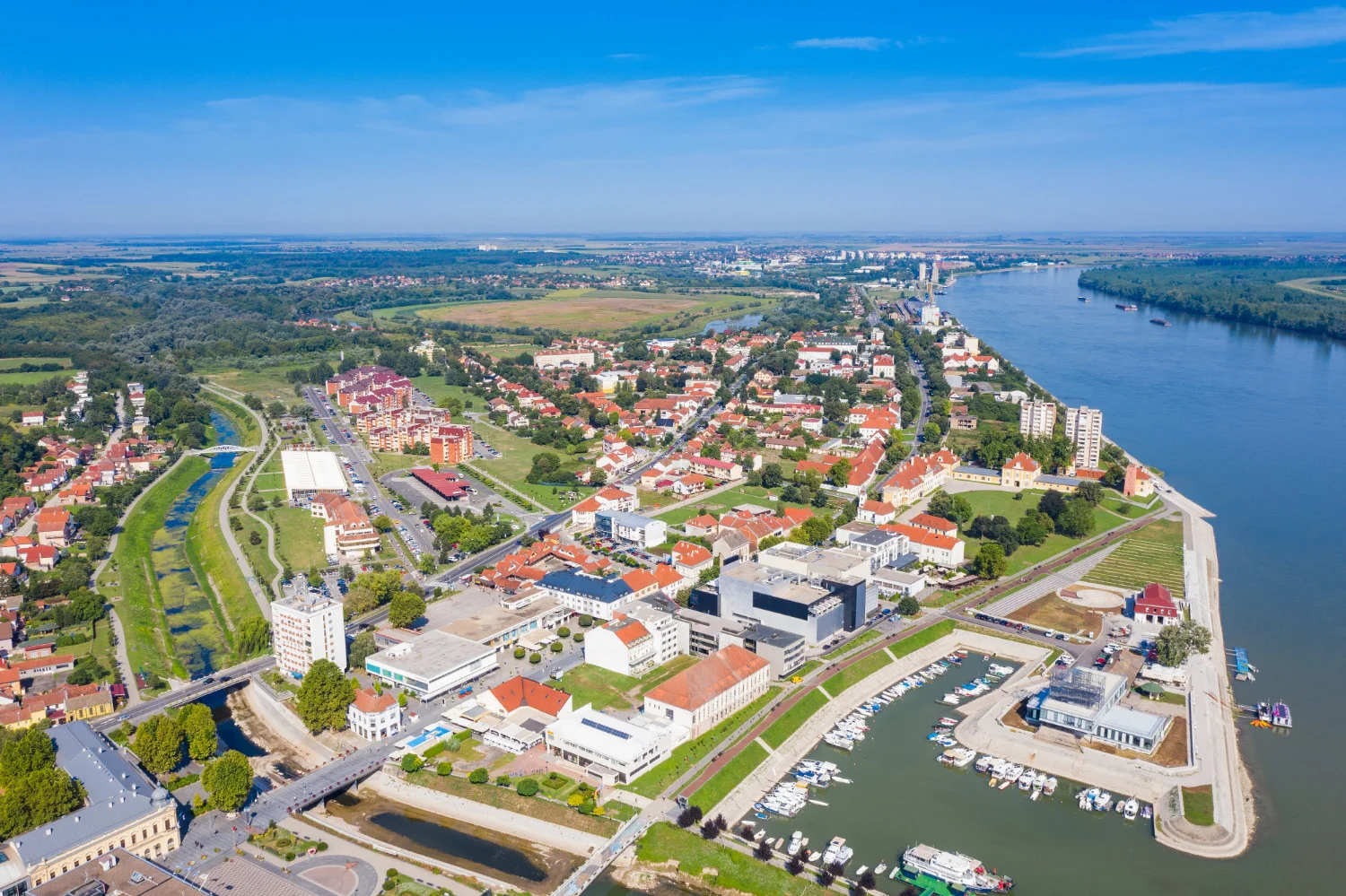
There are three car ferry connection options to get from Italy to Croatia across the Adriatic Sea, by any vehicle except a bicycle:
- Ferries from Ancona to Split
- Ferries from Ancona to Zadar
- Ferries from Bari to Dubrovnik.
Note that there are other ferry departing points, such as Venice (Italy), that cannot be used with a car. Once in Croatia, you can also catch internal ferries, such as from Zadar to Mali Losinj.
The ferry journey takes approximately 10 hours in most cases, for example from Ancona to Split. Not all services are operated all year round. Visit official ferry operator websites or, alternatively contact them, for trip schedules and prices. Many travellers enjoy this service as it offers something different.
Other Options for Transfers from Italy to Croatia
Book tickets in advance for the following:
There are no direct trains but it is the cheapest option. Catch a train from Trieste (Italy) to Ljubljana (Slovenia). Then take a train to Zagreb. Trains operated by Croatian Railways go to Split and continental Croatia.
Get tickets to Zagreb or elsewhere using direct bus options from Italy to Croatia that operate year round. Contact the service providers.
Numerous airlines service direct flight routes between Italy and Croatia, including Ryanair, Vueling Airlines, Croatia Airlines and ITA Airways. They fly to Zagreb, Split, Dubrovnik and elsewhere.
Although it may appear at first glance to be a difficult undertaking, travelling by road between Italy and Croatian is relatively simple. The road network throughout allows drivers to reach their chosen destinations efficiently. For EU citizens and Schengen holders, the lack of border formalities makes a journey through the region even more appealing.
Popular posts
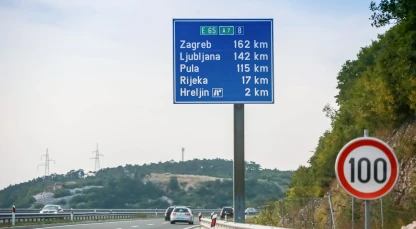
Understanding Speed Limits in Croatia: Safety on the Roads
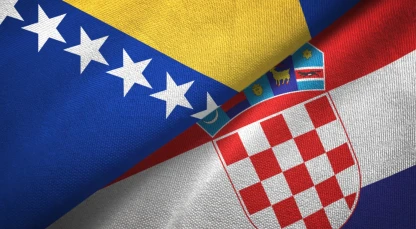
Border Crossings Bosnia-Croatia
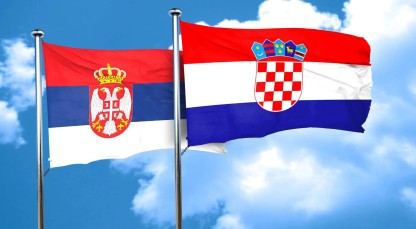
Travelling across the border from Serbia to Croatia by Road
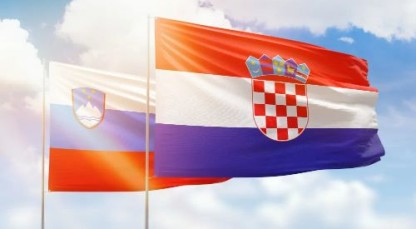
Border crossings Croatia and Slovenia border
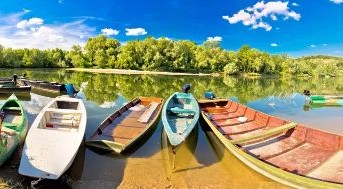
Croatia-Hungary Border Crossing
Are you sure.

- Dubrovnik ferry port
- Makarska ferry port
- Porec ferry port
- Prizna ferry port
- Pula ferry port
- Rijeka ferry port
- Rovinj ferry port
- Sibenik ferry port
- Split ferry port
- Stinica ferry port
- Umag ferry port
- Vodice ferry port
- Zadar ferry port
- Bol ferry port
- Brestova ferry port
- Hvar ferry port
- Jelsa ferry port
- Korcula ferry port
- Milna ferry port
- Preko ferry port
- Rogac ferry port
- Stari Grad ferry port
- Supetar ferry port
- Ubli ferry port
- Vis ferry port
- Vela Luka ferry port
- Island Brac
- Island Cres
- Island Dugi Otok
- Island Hvar
- Island Korcula
- Island Lastovo
- Island Losinj
- Island Mljet
- Island Pasman
- Island Solta
- Island Ugljan
- Jadrolinija
- TP line Dubrovnik
- Adriatic lines
- G&V Line Zadar
- Rapska Plovidba
- Catamaran Line
- Krilo Shipping Company
- Venezia Lines
- Liberty Lines
- Gomo Viaggi
- Smaller Ferry Companies

Find your ferry
Ferry italy to croatia.
Despite Italy and Croatia being almost connected by a land border in the northeastern corner of the Adriatic sea, taking a ferry when travelling between the countries is in most cases both faster and cheaper . Most of the ferry connections between the countries only operate during the summer season which usually covers May, June, July, August, September and a bit of October. However, there are also ferry routes from Italy to Croatia which operate the whole year.
Table of Contents
Car ferry Italy to Croatia
If you are travelling by car there are 3 possible travel routes, Bari to Dubrovnik, Ancona to Zadar or Ancona to Split, these car ferry routes operate year-round, in the winter season twice a week in the summer season 4 or more times a week, all 3 are operated by Jadrolinija. The route Ancona to Split is also operated by SNAV during the summer season, some years SNAV has been using a traditional car ferry for the route, other years they have operated the route with a fast ferry/catamaran jet.
Italian ports with ferry to Croatia
The company Triestelines used to operate a Hydrofoil/fast ferry connection from Trieste to Porec, Rovinj and Pula, the line has now been taken over by Libertylines which are scheduled to operate the line from 2020:
The port in Venice is one of the main port for travelling between Italy and Croatia, several companies operate fast ferry/catamaran connections from the historical town, to towns in Istria and to Island Losinj , the connection available usually change from year to year, but the following ones are available each year.
The recent year the ferry company Gomo Viaggio, has been operating a summer route between Cesenatico and towns in Istria and Kvarner , due to coronavirus this line has been cancelled for 2020 but should return for the 2021 season.
The ferry company Gomo Viaggio has also been offering a fast ferry summer connection from Pesaro to Losinj, Pula, Rab, Novalja and Rovinj, also this lines has been cancelled for 2020 due to the coronavirus but should return for the 2021 season.
Ancona is the main Italian Sea gateway to Croatia , as mentioned above two of 3 whole year car ferry connections operate from here, the ferry from Zadar to Ancona , it optimal for those going to the mid and northern part of Croatia, as well as passengers travelling to the northern part of Bosnia. The ferry from Ancona to Split is optimal if you are travelling to Dalmatia , or places like Sarajevo, Mostar and Medjugorje in Bosnia and Herzegovina.
Civitanova Marche
From Civitanova Marche there used to be a fast ferry connection to Split operated by Gomo Viaggio, but as for now, the route has been discontinued.
The company SNAV several years operated a summer connection between Pescara and Hvar and Split , currently the company does not operate this route.
A few years ago the travel company GSTravel started a fast ferry route between Termoli and Ploce in Croatia. The route, with a sailing time of only 4.5 hours, was a great way of getting to the southern part of Croatia from Italy. For 2020 the route will not operate and it is not clear if it will be back in 2021.
The southernmost Italian port with a ferry connection to Croatia , as mentioned above there is a whole year car ferry connection between Bari and Dubrovnik. The ferry connection is operated by Jadrolinija .
Price ferry Italy to Croatia
Obviously, with the many ferry connections , there are a lot of different prices. The summer connections with the foot passenger ferries usually range from 70 -110 Euro for a one way adult ticket, early birds and other special offers for people who plan ahead are quite common.
Tickets for the car ferries are often sold for as little as 20 Euro or less in the winter season (Price for one passenger without vehicle) in summer season price is of course much higher. In July and August price can be up to 800 Euro or more for a vehicle and 4 passengers. This, of course, is a lot of money, but compared to the cost and time of driving around the Adriatic bay, it is justifiable. In general, planning ahead is a good idea, as the ferry companies often run campaigns.
Alternative to ferry Italy to Croatia
Driving with a car between Italy and Croatia is one alternative to taking the ferry, if you are doing a cost-benefit car vs ferry , remember to include the cost for road toll in Italy as well as in Croatia. Also if you travel in the main season, keep in mind the risk of having to wait at the border between Slovenia and Croatia.
Traveling by Bus from Italy to Croatia , is indeed an option, but the main one to consider if you are in the northern part of Italy e.g there is a bus from Venice to Pula and Venice to Zagreb if you travel from further west or south in Italy you will have to change bus at least once. From a price perspective, a bus is probably the cheapest way of travelling.
Taking a train from Italy to Croatia is not possible , the closest you can get by train is to Trieste from where you can then continue with a hydrofoil to Istria, or by bus to e.g Zagreb or Rijeka.
Flying between Italy and Croatia is of course also an option, but mainly in the summer season, exception is the route Rome to Split , which normally operates at least once a week year-round.
Map Ferry Italy to Croatia
Below you can see a map of the ferry connections between Italy and Croatia . In the menu on the map you can select to see connections e.g from Venice if you uncheck the other ferry ports. If you wish to see the timetable and operational period for a specific travel combination, you can use the search form at the top of the site!
The ports marked with purple and orange indicates that a passenger-only ferry operates from/to those ports, the ports marked with dark red and brown indicates a car ferry operates from the port.
- Travel Advisories |
- Contact Us |
- MyTravelGov |
Find U.S. Embassies & Consulates
Travel.state.gov, congressional liaison, special issuance agency, u.s. passports, international travel, intercountry adoption, international parental child abduction, records and authentications, popular links, travel advisories, mytravelgov, stay connected, legal resources, legal information, info for u.s. law enforcement, replace or certify documents.
Before You Go
Learn About Your Destination
While Abroad
Emergencies
Share this page:
Travel Advisory August 15, 2024
Croatia - level 1: exercise normal precautions.
Reissued after periodic review without changes.
Exercise normal precautions in Croatia.
Read the country information page for additional information on travel to Croatia.
If you decide to travel to Croatia:
- Enroll in the Smart Traveler Enrollment Program ( STEP ) to receive Alerts and make it easier to locate you in an emergency.
- Follow the Department of State on Facebook and X/Twitter .
- Review the Country Security Report for Croatia.
- Visit the CDC page for the latest Travel Health Information related to your travel.
- Prepare a contingency plan for emergency situations. Review the Traveler’s Checklist .
Embassy Messages
View Alerts and Messages Archive
Quick Facts
Three months after the planned date of departure
One page is required for an entry stamp
Up to 10,000 euros
Embassies and Consulates
U.s. embassy zagreb.
Ulica Thomasa Jeffersona 2 10010 Zagreb, Croatia Telephone: +(385) (1) 661-2200 Emergency After-Hours Telephone: +(385) (1) 661-2200 Fax: +(385) (1) 665-8933 Email: [email protected]
Destination Description
Learn about the U.S. relationship to countries around the world.
Entry, Exit and Visa Requirements
You need a valid U.S. passport to enter Croatia. EU regulations require that U.S. passport holders have no less than three months’ validity when they depart Croatia. U.S. passport holders with less than three months may be denied entry. The U.S. Embassy strongly suggests that you have at least six months of validity to avoid problems when you travel.
Croatia is a member of the Schengen area. Land border controls between Croatia, Slovenia, and Hungary and the sea border with Italy ceased in 2023. The land borders with Serbia, Bosnia and Herzegovina, and Montenegro continue to have police and customs checks in place, as these countries are outside of the Schengen area. Airport controls for flights between Croatia and other countries within the Schengen area ceased in 2023. Visit the Embassy of Croatia website for the most current visa information.
- U.S. passport holders do not need a visa if they are traveling to Croatia for tourism or business for less than 90 days within a 180-day period.
- For entry, residence, and work requirements in Croatia, please visit the Croatian Ministry of Interior’s website . The U.S. Embassy is not able to intervene in the issuance of a Croatian residence permit.
- You must register at a local police station within three days of arrival in Croatia. If you are staying at a hotel, hostel, or vacation rental, you will be registered by the property owner.
- Foreign documents submitted for residence in Croatia must be translated into Croatian and have an apostille stamp. The U.S. Embassy cannot authenticate documents. For information on applying for apostille and authentication services, please see the Department of State’s Office of Authentications website.
The U.S. Department of State is unaware of any HIV/AIDS entry restrictions for visitors to, or foreign residents of, Croatia.
Find information on dual nationality , prevention of international child abduction , and customs regulations on our websites.
Military/Status of Forces Agreement (SOFA) Travelers : While active-duty U.S. military personnel may enter Croatia under the SOFA with proper Department of Defense (DOD) identification and travel orders, all SOFA family members, civilian employees, and contractors must have valid passports. Active-duty military personnel should obtain a tourist passport before leaving the United States to accommodate off-duty travel. DOD travelers should consult with their unit for clearance before leaving the United States
Safety and Security
Terrorism : Terrorist groups and those inspired by such organizations are intent on attacking soft targets and are increasingly using less sophisticated methods of attack – including knives, firearms, rudimentary IEDs and vehicles – to target crowds more effectively. Frequently, their aim is unprotected or vulnerable targets, such as:
- High-profile public events (sporting contests, political rallies, demonstrations, holiday events, celebratory gatherings, etc.)
- Hotels, clubs, and restaurants frequented by tourists
- Places of worship
- Shopping malls and markets
- Public transportation systems (including subways, buses, trains, and scheduled commercial flights)
For more information, see our Terrorism page.
Land Mines: Armed conflict ended in all parts of Croatia in 1995; however, de-mining of areas along former confrontation lines continues. Known mined areas are well marked with Croatian-language warning signs using the international symbol for mines: a skull and crossbones inside a red, upside-down triangle. Drivers in former conflict areas should stay on paved roads to reduce the risk of encountering unmarked mines and unexploded ordnance.
- For more information about mine-affected areas in Croatia, please visit the Croatian Mine Action Center's website
Crime: Violent crime is rare but isolated attacks targeting specific persons or property can occur and may be racially motivated or prompted by lingering ethnic tensions from Croatia's war for independence.
- Safeguard your belongings , especially when using public transport. Report incidents of theft to the local police. File a police report if your passport is stolen.
- Don’t display outward signs of wealth . It may make you a target for thieves.
- Avoid "gentlemen's clubs." In the past, such establishments have presented foreign customers with inflated bills and threatened those who refuse to pay.
U.S. business entities are encouraged to read the most recent Overseas Security Advisory Council (OSAC) Annual Crime and Safety Report for Croatia .
Demonstrations : While civil disorder is rare, U.S. citizens should monitor local media coverage, review their personal security practices, and be always aware of their surroundings. Even peaceful demonstrations can turn violent with little or no notice. Security messages about demonstrations can be found here on the U.S. Embassy in Croatia’s website. Some soccer matches result in violent clashes of fans from rival teams. These clashes often cause disruptions in traffic in the affected area. High profile matches are often accompanied by heavy police presence.
International Financial Scams: See the Department of State and the FBI pages for information on scams.
Victims of Crime : Local authorities are responsible for investigating and prosecuting crimes. Report crimes to the local police by dialing 112. U.S. citizen victims of sexual assault may contact the U.S. Embassy at +385 (1) 661-2200 and check the information on local resources for victims of sexual assault on the U.S. Embassy in Croatia’s website. See our webpage on help for U.S. victims of crime overseas .
- help you find appropriate medical care
- assist you in reporting a crime to the police
- contact relatives or friends with your written consent
- explain the local criminal justice process in general terms
- provide a list of local attorneys
- provide our information on victim’s compensation programs in the United States
- provide information about local resources for victims of crime
- provide an emergency loan for repatriation to the United States and/or limited medical support in cases of destitution
- help you find accommodation and arrange flights home if you are destitute
- replace a stolen or lost passport
Domestic Violence : U.S. citizen victims of domestic violence may contact the U.S. Embassy in Croatia for assistance. You can find additional local resources for victims of domestic violence on the U.S. Embassy’s website.
Tourism: The tourism industry in Croatia is regulated and rules generally enforced regarding safety inspections. Hazardous areas/activities are identified with appropriate signage and professional staff is typically on hand in support of organized activities. In the event of an injury, appropriate medical treatment is widely available throughout the country. Outside of a major metropolitan center, it may take more time for first responders and medical professionals to reach a patient and provide assistance. U.S. citizens are encouraged to purchase medical evacuation insurance .
Local Laws & Special Circumstances
Criminal Penalties : You are subject to local laws. If you violate local laws, even unknowingly, you may be arrested, imprisoned, or deported.
Furthermore, some crimes are also prosecutable in the United States, regardless of local law. For examples, see our website on crimes against minors abroad and the Department of Justice website.
Arrest Notification : If you are arrested or detained, ask police to notify the U.S. Embassy immediately. See our webpage for further information.
Recreational Drugs : Some recreational drugs may be illegal in Croatia. The Government of Croatia maintains a List of Narcotic Drugs, Psychotropic Substances and Plants Which Can Be Used for Preparation of Narcotic Drugs , which lists illegal substances.
Counterfeit and Pirated Goods : Although counterfeit and pirated goods are prevalent in many countries, they may still be illegal according to local laws. You may also pay fines or have to give them up if you bring them back to the United States. See the U.S. Department of Justice website for more information.
Real estate : U.S. citizens should exercise due diligence when considering purchasing real estate in Croatia. Consult with an attorney before undertaking a real estate purchase and be careful to fully understand the implications of all parts of a real estate contract. Working with a translator can help ensure your rights are protected. The U.S. Embassy cannot assist U.S. citizens with legal disputes. Be prepared to take your case to the local courts. Please review the U.S. Embassy’s website for additional information on buying real estate in Croatia .
Travelers checks, or personal checks are no longer accepted in Croatia . ATMs are common, and credit cards are generally accepted. Facilities are available for wiring or transferring money.
Recreational Boating: The Croatian government requires all recreational captains chartering Croatian-flagged vessels to have a certificate of competence.
- Croatia recognizes certain certificates issued by the U.S. Sailing Association and licenses issued by the national authorities of other countries.
- Details on classes of licenses recognized by country can be found on the Ministry of the Sea, Transport, and Infrastructure ’s webpage.
- Tourists in Croatia can be certified by passing a test at harbormasters' offices in Pula, Rijeka, Senj, Zadar, Sibenik, Split, Ploce, Dubrovnik, or at the Ministry in Zagreb.
- Travelers arriving by private marine craft should refer to the Ministry’s website for information on nautical regulations.
Climbing and Hiking: If you intend to hike or climb in the mountains, seek local guides’ expert advice. For emergencies, call 112. Rock climbers in Paklenica National Park should consult a local guide or contact Paklenica National Park prior to their visit.
Faith-Based Travelers: See our following webpages for details:
- Faith-Based Travel Information
- International Religious Freedom Report – see country reports
- Human Rights Report – see country reports
- Hajj Fact Sheet for Travelers
- Best Practices for Volunteering Abroad
LGBTQI+ Travelers: There are no legal restrictions regarding same-sex sexual relations or the organization of LGBTQI+ events in Croatia. Although LGBTQI+ individuals are afforded full rights in Croatia, same-sex couples may face legal challenges in the areas of adoption and next-of-kin determinations. In 2014, Croatia enacted the Law on Life Partnership of Same Sex Couples allowing for formal registration of same sex unions. The LGBTQI+ community is protected by anti-discrimination laws, and there are no legal or governmental impediments to the organization of LGBTQI+ events. However, there have been incidents against LGBTQI+ groups, notably during annual pride events, both in Zagreb and Split. Individual cases of attacks on members of the LGBTQI+ community have also been reported.
See our LGBTQI+ Travel Information page and section six of our Human Rights Report for further information.
Travelers With Disabilities or Who May Require Accessibility . Accessibility and accommodation in Croatia are different from those in the United States. Croatian law prohibits discrimination against persons with disabilities. It also mandates access to transportation, communication, and public buildings for persons with disabilities; however, there is a marked difference in new construction compared to old construction, where access can still be limited. Croatia’s geography is hilly and often steep, particularly along the coast, and it presents challenges to some persons with disabilities. Access to public transportation may not always be available. Outside urban areas, accessibility worsens significantly.
Many cities in Croatia are making access improvement for travelers with disabilities.
Students: See our Students Abroad page and FBI travel tips .
Women Travelers: See our travel tips for Women Travelers .
Adequate medical care is readily available in Croatia, but facilities may not be comparable to U.S. standards. Travelers to Croatia may obtain a list of English-speaking physicians on the U.S. Embassy’s website. We do not endorse or recommend any specific medical provider or clinic. You may need a prescription to get some medications that you can purchase over the counter in the United States.
For emergency services in Croatia, dial 194 or 112.
Ambulance services are:
- not widely available, and training and availability of emergency responders may be below U.S. standards.
- not equipped with state-of-the-art medical equipment.
Health facilities in general:
- Adequate health facilities are available in major cities but health care in rural areas may be below U.S. standards.
- Public medical clinics may lack advanced resources and specialized medical supplies.
- Credit card payment is not always available. Some hospitals and medical professionals require cash payment.
- Private hospitals may require advance payment or proof of adequate insurance before admitting a patient.
- Travelers should make efforts to obtain complete information on billing, pricing, and proposed medical procedures before agreeing to any medical care.
- Medical staff may speak little or no English.
- Public hospitals are minimally staffed overnight in non-emergency wards.
- Patients bear all costs for transfer to or between hospitals.
- Psychological and psychiatric services are limited, even in the larger cities, with hospital-based care only available through government institutions.
- There are shortages of medical staff (nurses, doctors) throughout the country that may delay exams, imaging, surgeries, etc. at public healthcare centers. Occasionally shortages of special medications may occur.
We do not pay medical bills. U.S. Medicare does not apply overseas.
Medical Insurance: Make sure your health insurance plan provides coverage overseas. Most care providers in Croatia accept cash or credit card payments. See our webpage for more information on insurance coverage overseas.
We strongly recommend supplemental insurance to cover medical evacuation.
Pharmaceuticals
- Prescription medication: If traveling with prescription medication, please check with the government of Croatia and its Customs Administration to make sure the medication is legal in Croatia. Always carry your prescription medication in original packaging with your doctor’s prescription. Visit the U.S. Embassy’s website for information on bringing medical drugs for personal use when traveling to Croatia . Note that Croatian law prohibits the importation of drugs via postal mail.
- Exercise caution when purchasing medication overseas. Medication should be purchased in consultation with a medical professional and from reputable establishments.
- U.S. Customs and Border Protection and the Food and Drug Administration are responsible for rules governing the transport of medication back to the United States. Medication purchased abroad must meet their requirements to be legally brought back into the United States. Medication should be for personal use and must be approved for usage in the United States. Please visit the U.S. Customs and Border Protection and the Food and Drug Administration websites for more information.
Vaccinations : Be up-to-date on all vaccinations recommended by the U.S. Centers for Disease Control and Prevention.
- If you will be in Croatia for more than three months, especially if you anticipate hiking, camping, or other outdoor activities in forested areas, you may wish to get a tick-borne encephalitis (TBE) vaccine. According to the CDC, the TBE vaccine is now available in the United States, but is carried only in larger travel clinics.
If you are in Croatia, it is available from local doctors. Use insect repellent and inspect your body for ticks after spending time outdoors.
- Influenza is prevalent during the winter season.
- HIV/AIDS: There is a low prevalence of HIV/AIDS in Croatia. HIV/AIDS treatment and medication are available in Croatia.
Visit the U.S. Centers for Disease Control and Prevention website for more information about Resources for Travelers regarding specific issues in Croatia.
Medical Tourism and Elective Surgery
Medical tourism is a rapidly growing industry. People seeking health care overseas should understand that medical systems operate differently from those in the United States and are not subject to the same rules and regulations. Anyone interested in traveling for medical purposes should consult with their local physician before traveling and visit the U.S. Centers for Disease Control and Prevention website for more information on medical tourism, the risks of medical tourism, and what you can do to prepare before traveling to Croatia.
- We strongly recommend supplemental insurance to cover medical evacuation in the event of unforeseen medical complications.
- Your legal options in case of malpractice are very limited in Croatia.
- Although Croatia has several elective/cosmetic surgery facilities that are on par with those found in the United States, the quality of care varies widely. If you plan to undergo surgery in Croatia, make sure that emergency medical facilities are available and that professionals are accredited and qualified.
Adventure Travel
Visit Adventure Travel and U.S. Centers for Disease Control and Prevention for more information.
Air Quality : Cities in Croatia have air pollution levels slightly higher than those in major U.S. cities, with higher levels measured in winter. Visit the European Environment Agency’s website for information on air quality in Croatia.
Water Quality
- Croatia has an abundance of fresh water and the public drinking water systems cover around 87% of the population. Water quality is tested daily throughout the country. Tests are performed according to internationally accepted standards. Water in Croatia is of high quality with potable tap water being available in most places. Some rural areas rely on private wells that may not be subject to quality testing standards. Some older buildings in major cities may have led-laced piping leading to increased levels of lead in the drinking water. You can learn more by visiting the Croatian Institute of Public Health website .
Further health information:
- World Health Organization
- U.S. Centers for Disease Control and Prevention (CDC)
Travel and Transportation
Road Conditions and Safety : Road conditions in Croatia may differ significantly from those in the United States. Current information about traffic and road conditions is available in English from the Croatian Automobile Association (HAK) or by calling +385 1 464-0800 (English-speaking operators available 24 hours) or +385 1 661-1999.
- Exercise caution when driving in Croatia. On the highways, be aware of aggressive drivers passing on curves or in oncoming lanes.
- Highway tolls are higher than in the United States and can be paid in cash or by credit card.
- Croatian radio broadcasts programs in foreign languages on several frequencies. From mid-June to mid-September, Channel 2 broadcasts foreign news, traffic information, and important information in English, German and Italian.
- Within Croatia, emergency roadside assistance is available by calling 1987 or, if calling internationally, +385 1 1987. Dial 112 or 192 to speak to the police and dial 194 for an ambulance. Dial 112 for emergency services and they will automatically forward your call to either the police, ambulance, fire department, the Croatian Mountain Rescue Service or all of the above.
Traffic Laws: Vehicles drive on the right side of the road and overtake on the left. Speed limits range from 110 to 130 km/h (68 to 80 mph) on highways and motorways and 50 to 90 km/h (30 to 55 mph) on urban thoroughfares.
- A Croatian driver's license is required for drivers who stay longer than twelve months.
- Don’t drink and drive . The maximum legal blood-alcohol limit for drivers is 0.05 percent (0.00 percent for drivers with less than two years’ experience, drivers under 24 years of age, and truck or bus drivers).
- Police routinely spot-check for drunk driving and administer breath-analyzer tests at the scene of all accidents. Refusal to take a breath test is considered a de facto admission of driving while intoxicated. Penalties may include fines up to 2,500 euros and/or prison sentences.
- For traffic accidents involving a foreign-registered vehicle, the responding police officer must issue a vehicle damage certificate to the owner of the foreign-registered vehicle; this is necessary to cross the border out of Croatia. Upon written request, the police station in the area where the accident occurred will issue a traffic accident investigation record.
- Seat belts for drivers and passengers are mandatory . Infants must travel in child-safety seats. Children shorter than 150cm in height and younger than 3 years may not ride in the front seat.
- No right on red at traffic lights unless allowed by an additional green arrow.
- Pedestrians have the right of way when crossing in designated, white-striped crosswalks. You must stop.
Headlights must be used all winter (from the start of November until the end of March), as well as during fog and other inclement weather.
- It is illegal to talk on a cell phone while driving unless using a hands-free device.
- For specific information concerning Croatian driver's permits, vehicle inspection, road tax, and mandatory insurance, please contact the Croatian National Tourist Board .
Public Transportation : Pay attention to trams (streetcars) in Zagreb, which travel at high speeds through the narrow streets.
See our Road Safety webpage for more information. Visit the websites of the Ministry of the Interior , the Croatian National Tourist Board , and the Croatian Ministry of the Sea, Transport, and Infrastructure , which are responsible for road safety.
Aviation Safety Oversight: The U.S. Federal Aviation Administration (FAA) has assessed the Government of Croatia’s Civil Aviation Authority as being in compliance with International Civil Aviation Organization (ICAO) aviation safety standards for oversight of Croatia’s air carrier operations. Further information may be found on the FAA’s safety assessment page .
For Coastal Countries:
Maritime Travel: Mariners planning travel to Croatia should also check for U.S. maritime advisories and alerts at www.marad.dot.gov/msci . Information may also be posted to the U.S. Coast Guard homeport website and the NGA broadcast warnings website (select “broadcast warnings”).
For additional travel information
- Enroll in the Smart Traveler Enrollment Program (STEP) to receive security messages and make it easier to locate you in an emergency.
- Call us in Washington, D.C. at 1-888-407-4747 (toll-free in the United States and Canada) or 1-202-501-4444 (from all other countries) from 8:00 a.m. to 8:00 p.m., Eastern Standard Time, Monday through Friday (except U.S. federal holidays).
- See the State Department’s travel website for the Worldwide Caution and Travel Advisories .
- Follow us on X (formerly known as "Twitter") and Facebook .
- See traveling safely abroad for useful travel tips.
Review information about International Parental Child Abduction in Croatia . For additional IPCA-related information, please see the International Child Abduction Prevention and Return Act ( ICAPRA ) report.
Travel Advisory Levels
Assistance for u.s. citizens, croatia map, learn about your destination, enroll in step.

Subscribe to get up-to-date safety and security information and help us reach you in an emergency abroad.
Recommended Web Browsers: Microsoft Edge or Google Chrome.
Make two copies of all of your travel documents in case of emergency, and leave one with a trusted friend or relative.
Afghanistan
Antigua and Barbuda
Bonaire, Sint Eustatius, and Saba
Bosnia and Herzegovina
British Virgin Islands
Burkina Faso
Burma (Myanmar)
Cayman Islands
Central African Republic
Cote d Ivoire
Czech Republic
Democratic Republic of the Congo
Dominican Republic
El Salvador
Equatorial Guinea
Eswatini (Swaziland)
Falkland Islands
France (includes Monaco)
French Guiana
French Polynesia
French West Indies
Guadeloupe, Martinique, Saint Martin, and Saint Barthélemy (French West Indies)
Guinea-Bissau
Isle of Man
Israel, The West Bank and Gaza
Liechtenstein
Marshall Islands
Netherlands
New Caledonia
New Zealand
North Korea (Democratic People's Republic of Korea)
Papua New Guinea
Philippines
Republic of North Macedonia
Republic of the Congo
Saint Kitts and Nevis
Saint Lucia
Saint Vincent and the Grenadines
Sao Tome and Principe
Saudi Arabia
Sierra Leone
Sint Maarten
Solomon Islands
South Africa
South Korea
South Sudan
Switzerland
The Bahamas
Timor-Leste
Trinidad and Tobago
Turkmenistan
Turks and Caicos Islands
United Arab Emirates
United Kingdom
Vatican City (Holy See)
External Link
You are about to leave travel.state.gov for an external website that is not maintained by the U.S. Department of State.
Links to external websites are provided as a convenience and should not be construed as an endorsement by the U.S. Department of State of the views or products contained therein. If you wish to remain on travel.state.gov, click the "cancel" message.
You are about to visit:
From Italy to Croatia on Two Wheels
By Alex Crevar May 24, 2022
- Share full article
From Italy to Croatia ...
... on two wheels.
By Alex Crevar Photographs by Susan Wright May 25, 2022
A bike ride from Trieste, Italy, through Slovenia, to the ancient city of Pula, Croatia, starts from the Adriatic coast’s 90-degree bend on the sea’s northern coast and rolls down its eastern shore to the tip of the Istria peninsula. The 150-mile leisurely journey brims with ancient traditions, sublime food and perched-village photo ops. History here is measured in millenniums and empires: Roman, Byzantine, Venetian, Napoleonic, Austro-Hungarian.

Adriatic Sea
Gulf of Trieste
Secovlje Salina
Nature Park
Istrian Peninsula
The ride follows two routes: the EuroVelo 8 and the Parenzana Trail . The trails overlap for much of the itinerary before separating and then reuniting on Croatia’s Istrian coast. The six-stage ride covers between 22 and 30 easy-to-moderate miles per day, with occasional challenging ascents. Cyclists pedal enough to see loads of culture while earning their seafood, pasta and wine — but not so much that they’ll be exhausted.
You’ll start in Trieste by hopping on the 4,700-mile EuroVelo 8 (EV8), which extends from Cádiz, Spain, to Cyprus. The EV8 is part of the EuroVelo network, which began 25 years ago with 12 routes crisscrossing the continent. Today, the network connects 42 countries on 17 routes, covering more than 50,000 miles. The most recent trail , running from Austria to Hungary, was added in 2020.
“The fact that more people are taking up cycling is great for all of us,” EuroVelo ’s director, Ed Lancaster, recently told me. “Cycling supports local economies,” he said, noting that it also “reduces tourism’s environmental footprint.”

South of Trieste, in Muggia, Italy, the EV8 overlaps with the Parenzana Trail through Slovenia. The routes diverge in Croatia, where you’ll take the Parenzana, which follows the path of the former Parenzana railroad. Built by the Austro-Hungarian Empire in 1902, the train connected 33 stations over 76 miles from Trieste to the Croatian town of Poreč, on the Istrian coast. Today it provides a cycling corridor through communities known for truffles, olive oil and wine.
Both the EV8 and the Parenzana roll across multiple surfaces: bike paths removed from traffic; roads and byways, often with little traffic; and gravel trails through vineyards and forests.
Among the reasons I suggest this ride: The stages are short, signage is regular and the path is packed with villages and services. On a recent trip, I stayed at bike-friendly hotels and guesthouses, and set off each morning around 8 a.m., giving myself plenty of time to explore.

Day 1: 30 Miles from Trieste to Piran, Slovenia
A smooth start on the coast.

After arriving in Trieste from Ljubljana, where I live, I started my journey with a two-cup morning in the home of the Illy coffee company and, arguably, Italy’s coffee capital. The first stop was the Illy Ponterosso cafe at the mouth of Canal Grande, whose outdoor tables overlook the canal flowing into the Gulf of Trieste. As I sipped an espresso, I inspected my gravel bike (a hybrid with road-bicycle geometry and off-road sturdiness). It was loaded with bags for clothes, tools, maps and notebooks. Behind me, the statue of James Joyce, who lived and wrote in Trieste, seemed to prod me to my next cup on the Piazza Unità d’Italia, said to be Europe’s largest sea-facing square, where I sat at the Caffe degli Specchi amid Hapsburgian architectural pomp. By the time I finished my coffee, I was ready to hit the trail.
From the piazza, I jumped directly onto the EuroVelo 8 and rode for nearly nine miles on two-lane roads and bike paths to the fishing village of Muggia, where the Parenzana Trail begins and the two routes merge. I crossed into Slovenia, which immediately lived up to its reputation for cycle-based travel. For most of the country, the asphalt path — often running parallel to traffic as it passes towns and runs through occasional stretches of forests — is flat, dedicated to bicyclists.
My first stop — at a pekarna (bakery) for a chocolate croissant — was in Koper. Slovenia’s only shipping port feels industrial until you reach its medieval, Venetian Republic-era center. I pushed my bike across cobbled streets leading to Tito Square, home to the 13th-century Praetorian Palace and the 177-foot City Tower , with views down the coast.
The path hugged the shore to Izola , with its laid-back marina filled with sailboats and fishing skiffs, and climbed into the forested countryside. Soon I entered the first of several old stone tunnels along the Parenzana Trail. On the other side of the 600-yard Valeta Tunnel, the trail descended into farms and vineyards.
The seaside resort of Portorož came into view and, beyond it, Piran, another town with ancient roots and Venetian landmarks. Here I took a local bike path from Portorož to Piran , which sat on the tip of a finger-shaped peninsula pointing at Italy.

That evening, at the family-run restaurant Pri Mari , I ordered a glass of local pinot blanc and the John Dory (a flaky, white fish) baked with herbs. Dessert was a pear cooked in red refosco wine, drizzled with chocolate. Over the span of 30 miles, I had rolled across two countries and five coastal towns.

Day 2: 23 Miles from Piran, Slovenia, to Grožnjan, Croatia
Into croatia on the parenzana trail.

Asphalt changed to gravel when I crossed into Croatia. As I pedaled along the border, Slovenia’s Secovlje Salina Nature Park — where one can visit ancient salt flats — filled the vista. Soon after, the two routes forked. The EuroVelo 8 continues to the Adriatic (I would rejoin it in Porec), and the Parenzana, which I followed, made a U-turn as it headed into Istria’s inland, foodie center.
I pedaled on the packed-gravel path that ran alongside a remote state road, steadily ascending from an elevation of around 250 feet to about 950 feet. In the hilltop town of Buje, I stopped for a beer-tasting at San Servolo Resort . Nestled in wine country, Istria’s best beer maker has built a compound with a brewery, steakhouse, pizzeria, hotel and spa with brew baths.

I continued my relaxed ascent to Grožnjan , a bohemian village perched at around 900 feet, where a Neolithic fort once monitored the peninsula below. Today, artists’ ateliers line its pedestrian-only streets and draw visitors, who flock here every summer for a jazz festival , as well as drama, music, dance and meditation workshops.
I pushed my bike along stone alleyways to Vero , a cafe-bar with views of the Mirna River Valley and the Motovun Forest, where white and black truffles grow beneath oak, ash and beech trees. I ordered a glass of biska, homemade mistletoe schnapps. In the distance, Motovun, another perched village and the next day’s destination, poked through the clouds.

Day 3: 22 Miles from Grožnjan to Motovun, Croatia
In the land of truffles.

Since this was my shortest riding day (17 miles), and would often have me on a gradual descent, I decided to take a five-mile detour for lunch. In the town of Livade, I turned east on a service road that parallels the Mirna River and pedaled to the community of Gradinje and Konoba Dolina , where I sat on the restaurant’s wraparound porch.
I’ve been to Dolina several times — and, to me, this is quintessential Istria. Simple, inexpensive, homemade dishes, virtually all of which focus on truffles. People may associate the pungent fungus with France and Italy, but the tuber is a way of life in Istria, where, in 1999, the world’s largest white truffle was unearthed. (At nearly three pounds, it was, at the time, the Guinness World Record holder.)

The midday sun shone on my face when a glass of malvasia, Istria’s classic white wine, arrived. “Truffle hunters and their dogs come straight from the woods to sell us what they’ve found,” the waiter said as he brought my starter of scrambled eggs with shaved white truffles. When he put a dish of fuži pasta (a sort of rustic penne) before me — again topped with white truffles — he said simply: “Don’t use Parmesan. You’ll hide the flavor.”
The day’s only real climb (around 600 feet) took me to Motovun. At the top, I walked the town’s steep, medieval, flagstone streets to Konoba Mondo , another intimate bistro famous for truffles, for my second round. I sat on the terrace where “Tartufi” (truffles in Croatian) was painted on a wooden sign on the wall. This time I had steak topped with slivers of black truffles, an Istrian red called teran, and the tavern’s knockout panna cotta in a wild-berry sauce.

Day 4: 23 Miles from Motovun to Porec, Croatia
Back toward the sea.

Istria is wine country. The Greeks grew grapes here more than 2,500 years ago. Today, there are hundreds of winemakers; over 100 are officially associated with the peninsula’s wine roads . Of the many varieties produced, the dominant two are malvasia, a white, and teran, a red.
As I rode to the coast, the Parenzana glided along a gravel trail that undulated through forests and vineyards; rows of vines rolled over the landscape like waves of corduroy.
I could smell the Adriatic before I saw it. Its fragrance, coupled with the sensation of traveling under my own power, gave way to exhilaration as I descended to the sea and the Parenzana Trail’s terminus in Porec’s historic center.
Porec’s Old Town is a compact tangle of streets resting on a spit of land thrust into the sea. Its recorded history dates back thousands of years. The Romans established an important colony, Parentium, in the second century B.C. However, it is the UNESCO-inscribed Euphrasian Basilica , from the sixth century A.D., that has become the town’s calling card. The sprawling Byzantine-era complex borders the shore alongside bars, shops and restaurants. I stood inside the central apse, mesmerized by the mosaics: a swirl of marble, ivory and mother-of-pearl.
After an awe-filled couple of hours, I walked through Old Town to Konoba Ćakula for seared tuna steak and then continued around the southwestern edge of the city’s peninsula to my room at the bike-friendly BO Hotel Palazzo .

Day 5: 27 Miles from Porec to Rovinj, Croatia
Challenging climbs along the ev8.

The Parenzana ended as I left Porec on the seaside Route 143, and the EuroVelo 8 took over for the last two days. Signage and scenery weren’t the only changes. The trail went from mainly gravel to mostly asphalt, and there was more climbing. This meant pacing myself up crests, which, on a positive note, provided great vantage points, and then using gravity through the troughs.
Such was the case as I pedaled through the town of Vrsar — where Casanova’s visits in the 1740s have inspired a historic center tour following his exploits — before climbing above the Lim Channel and then descending to its edge. At the bottom of the 7.5-mile-long, fjordlike channel, which feeds into the sea and creates perfect conditions for shellfish farming, I stopped at Restaurant Fjord (+385 52 448 222) on the channel’s banks. After a pick-me-up of a half-dozen European flat oysters harvested within view of my table, I climbed 492 feet back up the fjord’s south face.
The day ended in Rovinj , more than halfway down the coast. The sun was setting on the town’s row of pastel buildings overlooking the Adriatic. The center — another compact, peninsular collection of serpentine alleys — teemed with tourists and locals. Croats stood around converted-barrel tables drinking white wine next to the outdoor market. Visitors studied maps under the 17th-century Balbi’s Arch , which sits between the main square and Grisia Street . From there, they would lumber up the cobbled street, crowded with boutiques and galleries, to the hilltop, 18th-century Church of St. Euphemia.

I pushed my bicycle along the waterside promenade to La Puntulina and took a seat on the southwest-facing terrace. I ordered mussels steamed in wine, garlic and olive oil, and grilled sea bream and sipped a malvasia from the Matošević Vineyards, which I had cycled past near the Lim Channel, and watched the sun meet the sea.

Day 6: 25 Miles from Rovinj to Pula, Croatia
Hugging the coast on the final stretch.

By Day 6, I was used to the routine: wake, ride, explore. What I’ve never grown accustomed to, even living in the region for years, is the amount of culture packed into every locale along this 150-mile, three-country ride. Pula, Croatian Istria’s largest city and my final destination, was no exception.
A mix of industrial, shipbuilding grit and ancient culture, Pula is famous for its sprawling Roman amphitheater. I rode straight there, eager to see the first-century structure, known locally as the Arena . It is still in use as a concert venue and the site of the annual Pula Film Festival . I then pedaled to a cafe-bar on the main square — the site of the ancient Forum , from the first century B.C., and the Temple of Augustus.

A waiter carrying half-liter mugs filled with beer passed by. The end of my journey mirrored the beginning: After cycling from the top of Istria to the bottom, I was again on a plaza staring at the Adriatic. Like that morning in Trieste, which now seemed weeks ago, I decided to splurge with two drinks. This time I opted for ice-cold beer.

What, how and when?
For touring, I ride a gravel bike, which combines long-distance rideability with rough-and-tumble strength. I carry four bike packs: a seat pack for clothes; a frame pack for tools; a large handlebar pack for extra tools and toiletries; and a smaller handlebar pack for passport, wallet, notebooks and maps.
My trip began with a three-hour train ride from Ljubljana , where I live, to Trieste. In addition to the 9.90 euro (about $10.30) train ticket, there was an additional 5 euro charge for my bike . At the end of my tour, I took the train back to the Slovenian capital from Pula . (For those returning to Trieste, taking the train back through Ljubljana is still the fastest option.)
I recommend two bike rental spots in Trieste: Ones , next to the Canal Grande, and Trieste Green Tour , a five-minute walk north from the canal.
The ideal times for this ride are spring, when wildflowers are in bloom, but tourist season isn’t, and fall, when temperatures are perfect, and grape and olive harvests are in full swing.
There are campsites, private accommodations and hostels along the route . There are also bike-friendly hotels. For the lodgings below, rates are per night for doubles during the first week in June.
In Trieste , Urban Hotel Design welcomes cyclists with 49 rooms (€174, or about $182). In Piran , Slovenia, Hotel Piran , opened in 1913, is a seaside, four-star option (€156). Over the Croatian border in Grožnjan , the six-room B&B Artegnana 1798 is, like its hilltop village, full of character (€112). In old town Motovun , Villa Borgo (and annex) has 15 rooms and an apartment (779 Croatian kuna, or about $108). The 74-room, waterfront BO Hotel Palazzo in Porec is both chic and relaxed (€131). Rovinj ’s Hotel Eden is a great place to rest before the final stage (€230). Finish in Pula overlooking the Adriatic at Hotel Park Plaza Histria (€132).
Cycling Around the Globe
The cycling world can be intimidating. but with the right mind-set and gear you can make the most of human-powered transportation..
Are you new to urban biking? These tips will help you make sure you are ready to get on the saddle .
Whether you’re mountain biking down a forested path or hitting the local rail trail, you’ll need the right gear . Wirecutter has plenty of recommendations , from which bike to buy to the best bike locks .
Do you get nervous at the thought of cycling in the city? Here are some ways to get comfortable with traffic .
Learn how to store your bike properly and give it the maintenance it needs in the colder weather.
Not ready for mountain biking just yet? Try gravel biking instead . Here are five places in the United States to explore on two wheels.
Advertisement

Travelling from Venice to Croatia
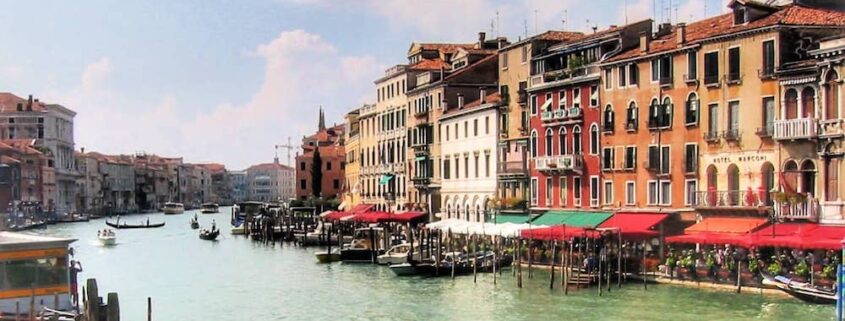
Travelling from Venice to Croatia is relatively straightforward because there are a number of ways of doing so – namely, catamaran, bus or flying! There are several flights from Venice to airports in Croatia (Split and Dubrovnik); with short flight times, it’s a relatively easy hop down to Dalmatia. (However, flights only operate in summer and aren’t daily.)
Another option for travelling from Venice would be to take one of the numerous daily trains from Venice Santa Lucia or Mestre stations to Trieste and then change there for more transportation options to Croatia. See the Trenitalia website for train timetables.
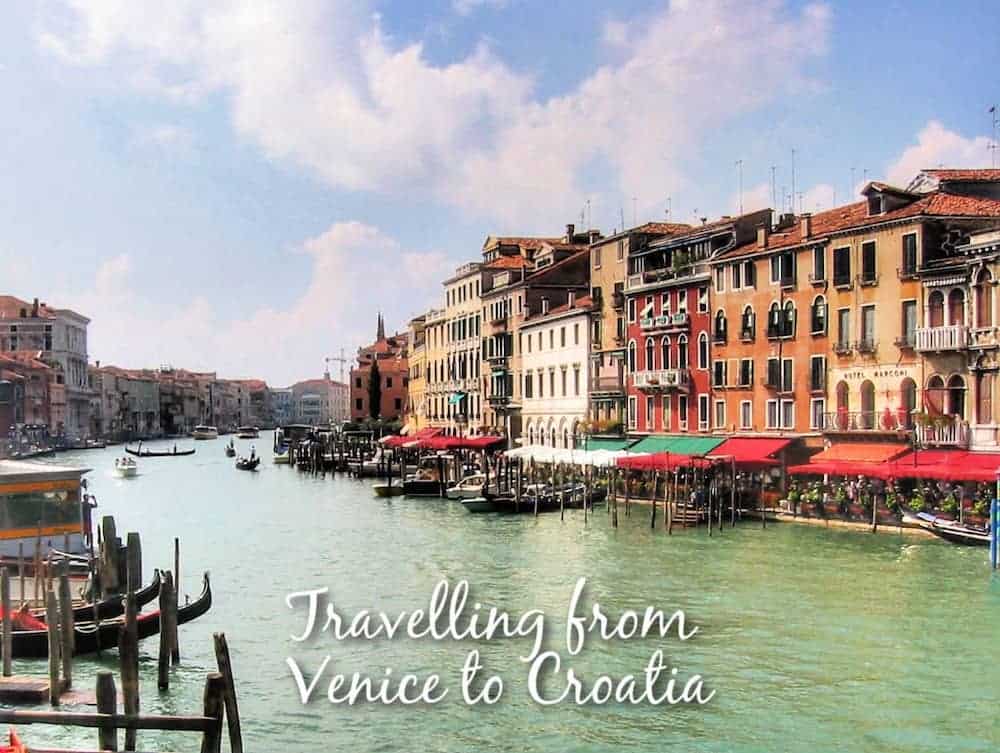
There are many cheap flights from the UK to Venice Marco Polo Airport, operated by various airlines. (There are also cheap flights to Venice Treviso, which is a completely different airport – see how to get from Treviso to Croatia .) So if you can’t find suitable flights direct to Croatia – to Istria in particular – flying to Venice instead and travelling across is very doable.
Travelling from Venice to Istria by catamaran
Venezia Lines operates routes from Venice to several Istrian ports – Porec , Rovinj , Pula and Rabac . Most services operate between June and September; more popular ones operate from April to October (e.g. Venice to Rovinj and Porec). Book online using the form below:
Travelling from Venice to Pula by Bus
There are several daily services from Venice to Pula – FILS and Brioni both run services, with the second company having a route that starts in Padua and stops in Buje and Rovinj along the way.
Crnja Tours also operates daily services from Venice to Pula as well – again, this route starts actually in Padua. The bus stops in Trieste, Koper (Slovenia), Umag , Novigrad , Porec and Rovinj before reaching Pula .
Travelling from Venice to Rijeka by Bus
Flixbus offers bus services on this route with a journey time of around 4 hours. You can find timetables on their website and also use it to purchase tickets.
Some of the Flixbus buses also make stops at Venice and Trieste Airports on the way to Rijeka, and some buses in fact start from further afield in Italy, such as from Florence, Bologna or Milan.
Flights from the UK to Venice Marco Polo
- British Airways Flights from London Heathrow and London Gatwick
- Easyjet Flights from London Gatwick, Bristol and East Midlands
- Jet2.com Flights from Birmingham, Leeds Bradford, Manchester and Edinburgh
- TUI Flights from London Heathrow, London City, Bristol and Manchester
(N.B. Not all of the above flights operate all year round.)
Can I travel from Venice to Split or Dubrovnik by ferry?
It’s a question we get asked quite frequently but, unfortunately, no – there are no ferries from Venice to either Split or Dubrovnik. Aside from the catamaran services to Istria and Mali Losinj (mentioned above), there is no ferry service from Venice to anywhere else in Croatia.
But what if I do want to get from Venice to Split or Dubrovnik? Flying from Venice to Croatia!
By far the easiest way of travelling from Venice to Dubrovnik is by air – Croatia Airlines operates this as a twice-weekly service in summer. If you’re utilising this route and want to get to Split, you could then also take a bus (about 4.5 hours) up to Split.
Easyjet flies from Venice to Split three times a week from April to October and to Dubrovnik twice a week in July and August.
Travelling by train
Otherwise, travelling by train isn’t really a suitable option – train services to Split will travel via Zagreb, so this will add on unnecessary hours to your journey. Travelling by train to Dubrovnik isn’t possible at all, of course, as the town has no train station.
You could travel from Venice to Trieste by train, and then take one of the daily buses from here to Split or Dubrovnik. See our guide on how to travel from Trieste to Croatia .
However, the bus journey from Trieste to Split/Dubrovnik is rather long, and it’s not everyone’s cup of tea being cooped in a bus for that long! In our opinion, therefore, the best way of travelling from Venice would be to take a train down the Italian side of the Adriatic, and then take a ferry across to Croatia. You should travel to Ancona for ferry services to Split (or Zadar) or to Bari for services to Dubrovnik.
Check for train schedules on the Trenitalia website, and then see our pages on travelling from Ancona and Bari .
Useful Travel Links
- Venice Airport Information on getting to/from the airport
- Trenitalia Train timetables for journeys within Italy
- Die Bahn European train timetables
More on Visit Croatia
About Visit Croatia
Contact Visit Croatia
Buy us a coffee!
Cookie Policy
Privacy Policy
Updated daily
New & Updated on Visit Croatia
Sightseeing in Pula A Wellness Break in Croatia Stari Grad Obonjan Bol Porec Two Days in Zagreb Slano How to do Croatia on a Budget Two Days in Split Nin Campsites in Croatia City Break in Croatia Two Days in Pula Family Holidays in Croatia 15 Things You May Not Know About Croatia Two Days in Zadar Koprivnica
Useful information on Croatia
Money in Croatia Visa Requirements for Croatia Buses in Croatia Ferries in Croatia Top Ten Destinations in Croatia Map of Croatia About Croatia

COMMENTS
Italy Travel Guides. Travel inspiration and top planning tips for getting around Italy. Read the travel guide Travelling Croatia's Dalmatian Coast by boat, bus, car and train. Discover the best ways to get around the Dalmatian Coast. Read the travel guide Getting to Rome from the airport. Get the details in Rome2Rio's airport-to-city travel ...
Italy Travel Guides. Travel inspiration and top planning tips for getting around Italy. Read the travel guide Travelling Croatia's Dalmatian Coast by boat, bus, car and train. Discover the best ways to get around the Dalmatian Coast. Read the travel guide Need to know: Jadrolinija. Learn all about travelling by ferry across the Adriatic Sea
The length of the ferry ride from Croatia to Italy can vary depending on the specific route and ports involved. Generally, ferry rides from Croatian ports to Italian ports can range from around 6-10 hours. Travelers should check schedules and availability for specific routes when planning their journey.
Travelling by ferry from Croatia to Italy is often the easiest and fastest way of moving between the countries. Especially if you are going from the central or southern part of Croatia to central and southern Italy. The car ferry connection from Split to Ancona is available year-round, the passenger-only ferries only operate in the period from ...
Days 1-2: Rome, Italy. Days 3-4: Venice. Day 5: Venice and fly to Zagreb, Croatia. Days 6-7: Zagreb. Days 8-9: Plitvice Lakes National Park. Day 10: Departure. Explore a 10-day itinerary that combines art appreciation in Italy with the natural wonders of Croatia. Begin by immersing yourself in Italy's rich history with visits to iconic ...
The crossing time by ferry from Croatia to Italy ranges between routes, operators and ships. Split - Ancona on average approximately takes 10h 46m. The distance from Split - Ancona is approximately 176.3 nautical miles. Sailings from Dubrovnik - Bari take on average 9 hours 50 minutes.
Rome2Rio makes travelling from Italy to Croatia easy. Rome2Rio is a door-to-door travel information and booking engine, helping you get to and from any location in the world. Find all the transport options for your trip from Italy to Croatia right here. Rome2Rio displays up to date schedules, route maps, journey times and estimated fares from ...
The option to travel from Italy to Croatia by ferry (or Croatia to Italy by ferry) is available from several major locations in both countries. The Italian city of Ancona is connected to three Croatian cities via two ferry operators, Jadrolinija and Snav, operating 0-3 times per day during high season. The routes available are:
With Eurolines, there's one daily bus that leaves Venice for Croatia - it departs at 10:45 and arrives at its last point in Croatia (Medulin) at 17:35. A ticket on Eurolines from Venice to Pula is roughly €24 one-way, or €48 round-trip. From Venice to Medulin is €26 one-way, or €52 round-trip.
Flights from Italy to Croatia. There are now a very good number of flights from Italy to Croatia. If you trying to reach Dalmatia (Split or Dubrovnik) from Venice, or places in Croatia from Central Italy (Rome), flying is undoubtedly the quickest way of travelling. Flights can also be pretty cheap as well, booked far enough in advance!
First Class flights to Italy. Business Class flights to Italy from $991. Prem Econ Class flights to Italy from $1,449. Economy Class flights to Italy from $23. Complete your trip to Italy with a hotel stay or car rental. The most popular flights on KAYAK according to clicks in the last 2 weeks.
10-Day Italy and Croatia Itinerary. If you have ten full days to explore Italy and Croatia, you have several more opportunities to see incredible sights and experience vibrant culture. As with the previous itinerary, you will start this ten day vacation by flying into Rome and spending three days exploring the sights.
Getting from Croatia to Italy can be done via plane (from select few airports) or via car, but we believe the best way to arrive in Venice is indeed by boat, given Venice's maritime history. Also, remember you can do it the other way around and travel from Italy to Croatia as a day trip from Venice.
The Trieste to Zagreb via Ljubljana service departs twice daily and takes about 8 hours, costing around 20 euros for a one-way ticket. In our opinion, the best way to travel from Croatia to Italy is to take a ferry from Italy to Croatia. Either that or fly into Italy and get a private transfer from Venice to Pula or Zadar.
The sailing time for the Croatia to Italy ferry ranges from 1 hour and 30 minutes to 11 hours.The Split to Ancona ferry takes approximately 10 hours and 46 minutes. The distance from Split to Ancona is approximately 176.3 nautical miles. Ferries from Dubrovnik to Bari takes approximately 9 hours and 50 minutes.
Travelling from Italy to Croatia by Bus. There is a daily bus service from Florence that travels via Bologna, Padua and Trieste to Zagreb (via Ljubljana and on to Belgrade and Sofia!) - it is run by Florentia Bus. Alternatively, there are also bus services from Venice and Trieste - please see details on these special pages.
In both cases it takes about three and a half hours to get from one country to another, making it the fastest way to get from Italy to Croatia on water. Others popular ferry lines are those that connect Ancona with Split or Bari with Dubrovnik, if you are travelling in the south of Italy. These ferry lines are longer and usually take a whole ...
Travelling to Croatia from Italy as a Non-EU Citizen. As a non-EU citizen wishing to enter Croatia or neighbouring countries Slovenia and Italy, check the visa requirements specific to your nationality. Visit the website of the Croatian Embassy or Consulate for detailed information while still in your home country.
What companies run services between Croatia and Venice, Italy? You can take a train from Zagreb Glavni Kol. to Venezia S. Lucia via Villach Hbf in around 8h 18m. Alternatively, Hisar Turizam operates a bus from Zagreb to Venezia Mestre once a week, and the journey takes 6h 30m. ... Rome2Rio makes travelling from Croatia to Venice easy. Rome2Rio ...
From Milan to Croatia by overnight bus. A new night bus from Milan to the Adriatic coast will depart each evening at 23.15 PM from the bus terminal Lampugnano (Milano), is operated by Croatia bus. The bus arrives at its first destination in Croatia, Rijeka, at 05:30 and continues from there to Crikvenica, Novi Vinodolski, Zadar, Sibenik and Split.
The cheapest flight deals from Croatia to Italy. Milan.$33 per passenger.Departing Tue, Sep 17, returning Thu, Sep 19.Round-trip flight with Ryanair.Outbound direct flight with Ryanair departing from Zadar on Tue, Sep 17, arriving in Milan Bergamo.Inbound direct flight with Ryanair departing from Milan Malpensa on Thu, Sep 19, arriving in Zadar ...
Compare cheap Croatia to Italy flight deals from over 1,000 providers. Then choose the cheapest or fastest plane tickets. Flight tickets to Italy start from £13 one-way. Set up a Price Alert. We price check with over 1,000 travel companies so you don't have to.
Car ferry Italy to Croatia. If you are travelling by car there are 3 possible travel routes, Bari to Dubrovnik, Ancona to Zadar or Ancona to Split, these car ferry routes operate year-round, in the winter season twice a week in the summer season 4 or more times a week, all 3 are operated by Jadrolinija. The route Ancona to Split is also operated by SNAV during the summer season, some years ...
Call us in Washington, D.C. at 1-888-407-4747 (toll-free in the United States and Canada) or 1-202-501-4444 (from all other countries) from 8:00 a.m. to 8:00 p.m., Eastern Standard Time, Monday through Friday (except U.S. federal holidays). See the State Department's travel website for the Worldwide Caution and Travel Advisories.
May 25, 2022. A bike ride from Trieste, Italy, through Slovenia, to the ancient city of Pula, Croatia, starts from the Adriatic coast's 90-degree bend on the sea's northern coast and rolls ...
Travelling from Venice to Pula by Bus. There are several daily services from Venice to Pula - FILS and Brioni both run services, with the second company having a route that starts in Padua and stops in Buje and Rovinj along the way. Crnja Tours also operates daily services from Venice to Pula as well - again, this route starts actually in Padua. The bus stops in Trieste, Koper (Slovenia ...